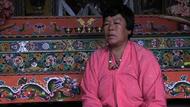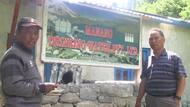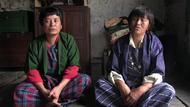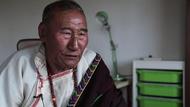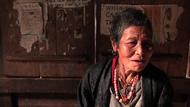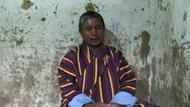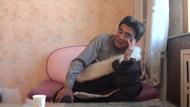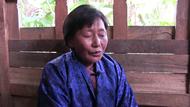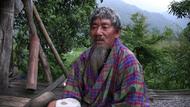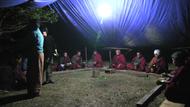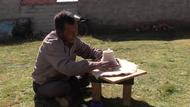Video Overview
A history of Drepung Monastery as related by a tantric chanting master.
- Drepung Monastery
- Chant Masterཐོག་མར་འབྲས་སྤུངས་དགོན་པ་ག་དུས་ཆགས་ཡོག་རེད་ཟེར་ན། ༡༤༡༦ལོར་འབྲས་སྤུངས་དགོན་པ་ཕྱག་བཏབ་པ་རེད་པཱ། ཕྱག་བཏབ་མཁན་དེ་རྗེ་བླ་མའི་དངོས་སློབ་རྗེ་འཇམ་དབྱངས་ཆོས་རྗེ་བཀྲ་ཤིས་དཔལ་ལྡན་པ་འོ་དེས་ཕྱག་བཏབ།Drepung Monastery was built in 1416 by Jamyang Chöjé Tashi Palden, a direct disciple of Je Tsongkhapa.
- Questionerལགས་སོ།Okay.
- Chant Masterགྲྭ་ཚང་བཞིའི་ནང་ནས་གྲྭ་ཚང་རྒན་ཤོས་སྒོ་མང་། དེ་ནས་འདུལ་བ་གྲྭ་ཚང་། དེ་ནས་བློ་གསལ་གླིང་གྲྭ་ཚང་། དེ་ནས་ཐོས་བསམ་གླིང་གྲྭ་ཚང་། དེ་ནས་ཕར་ཕྱིན་གྲྭ་ཚང་། འོ་དེ་ནས་བདེ་ཡངས་གྲྭ་ཚང་། འོ་འདུག་སེ་བྱས།Among the for prominent colleges, Gomang is the oldest one. Then we have Dulwa, Loseling, Tosamling, and Pharchin colleges. And other colleges like Pharchin and Deyang colleges.
- Questionerའོ།Okay.
- Chant Masterལྟ་སྔགས་པ་གྲྭ་ཚང་འདི་གྲྭ་ཚང་བཞི་ཆགས་དུས་འཇམ་དབྱངས་ཆོས་རྗེས་གྲྭ་ཚང་འཇུག་གུ་འཇུག་གུ་དེ་ལ། གྲྭ་ཚང་བདུན་གྱི་ནང་ནས་གྲྭ་ཚང་དྲུག་སྔོན་ལ་ཆགས།The tantric college was the last one to be built by Jamyang Chöjé.
- སྔགས་པ་གྲྭ་ཚང་འདི་འཇམ་མགོན་བླ་མའི་བཀའ་བསྒོས་གཞིར་བཟུང་རྗེ་འཇམ་དབྱངས་ཆོས་རྗེ་ལ་བཀའ་མངགས་ལྟར་གསང་སྔགས་གྲྭ་ཚང་འཛུགས་དགོས་པའི་ཞལ་གདམས་གནང་། ཞལ་གདམས་གནང་བ་ལ་བརྟེན་ནས། འཇམ་དབྱངས་ཆོས་རྗེས་སྔགས་པ་གྲྭ་ཚང་བཙུགས། སྔགས་པ་གྲྭ་ཚང་བཙུགས་ནས་ལོ་༥༨༠ཡན་མན་དེ་འདྲ་ཙམ་ཡོག་རེད།Heeding the advice of Je Tsongkhapa, Jamyang Chöjé built the tantric college according to his master's instructions, and it is now about 580 years old.
- Questionerལགས་སོ།Okay.
- Chant Masterལྟ་འདི་སྦུག་གི་བཙན་ཁང་ཞིག་ཡོག་རེད་པཱ། འདི་ཁྲ་འབྲུག་དང་། བསམ་ཡས་དང་དེ་ཚོའི་བཟོ་ལྟ་གཅིག་པ་རེད། འདི་ལོ་རྒྱུས་རིང་པོ་རེད།The tsen spirit temple inside the college, has similar structure like that of the Tradruk and Samye.
- Chant Masterའབྲས་སྤུངས་གྲྭ་ཚང་བཞི་མ་ཆགས་གོང་ནས་འཇིགས་བྱེད་ལྷ་ཁང་འདི་ཡོག་རེད། གྲྭ་ཚང་འདི་རྗེས་སུ་ཆགས།Before the four prominent colleges were built, that Yamantaka temple was already there.
- Questionerལགས་སོ།Okay.
- Questionerཨཱ་ནི།Then.
- Chant Masterའོ་ཡ་གིའི་བཙན་ཁང་སྦུག་མ་དེའི་རྗེ་རིན་པོ་ཆེའི་སྐྱོར་མོ་ལུང་ལ་བཞུགས། དགའ་བ་གདོང་ལ་བཞུགས། ཕ་གིར་ཟུལ་ཕུ་ལ་བཞུགས། སྣེ་ཐང་བདེ་བ་ཅན་ལ་བཞུགས། (ཚལ་)དགུང་ཐང་ལ་བཞུགས། བོད་ཀྱི་དགོན་དྲུག སེ་འབྲས་དགའ་གསུམ་མ་ཆགས་གོང་ལ་བོད་ཀྱི་དགོན་པ་དྲུག་ཆགས་པ་རེད་པཱ། དགའ་སྐྱོར་ཟུལ་གསུམ། གསང་སྣེ་དགུང་གསུམ་ཟེར་མཁན་གྱི་ཁ་ཐུག་ལ་འོ་འདི་ཆགས་བསྡད་ཡོག་རེད།Before the three great monasteries, namely, Sera, Drepung, and Gaden were built, Je Tsongkhapa stayed in six different monasteries in central Tibet. They are Kyormo Lung, Gawa Dong, Zülpu, Nétang Dewachen, Tselgungtang, and Sangpu monasteries.
- སྔགས་ཁང་འདི་ཆགས། སྔགས་ཁང་འདི་འབྲས་སྤུངས་མ་ཆགས་མ་ཆགས་གོང་ནས་འོ་འདུག་སེ་ཆགས། རྟེན་གཙོ་དེ་རྗེ་རིན་པོ་ཆེ་དགའ་བ་གདོང་དང་སྐྱོར་མོ་ལུང་ལ་གྲུབ་པ་ཉམས་ལེན་གནང་བྱས་བཞུགས་པའི་སྒང་ལ་གཟིམ་སྣང་ལ་འཇིགས་བྱེད་དེ་བྱུང་བ་རེད།That tantric house was built before the establishment of the Drepung monastery. Its central holy statue, Yamantaka, was said that it first appeared in the dream of Je Tsongkhapa when he was meditating at Kyormo Lung and Gawa Dong.
- གཟིམ་སྣང་བྱུང་བ་གཞིར་བཟུང་གིས་འཇམ་མགོན་བླ་མའི་བཀའ་བསྒོས་གཞིར་བཟུང་གྱིས་འཇིགས་བྱེད་འདི་བཞེངས། འཇིགས་བྱེད་གོང་མ་དེ་རྗེ་བླ་མ་ཁོ་རང་གི་ཕྱག་བཟོས་རེད། རང་བྱོན་དུ་གྲགས་པ།Based on that vision, the original Yamantaka statue was built according to of instructions of Je Tsongkhapa. As it was made based on his vision by himself, it was popularly known naturally appearing one.
- Questionerལགས་འོང་།Okay. I see.
- Chant Masterའདི་རང་བྱོན་དུ་གྲགས་པ་བྱས། འཇིགས་བྱེད་གོང་མ་དེ་ལ་སྐུའི་མགྲིན་པ་མན་ཆད་ལ་ས་ཐིགས་ཆུ་རེ་རེ་ལ་ཡ་མ་རཱ་ཛཱཿཁྲི་ཕྲག་རེ་རེ།It was said that the lower portion of the statue below the neck, a dot of soil and water of the figure contains the blessings of ten thousand yamaratsa, the sacred mantra of Yamantaka.
- མགྲིན་པ་ཡན་ལ་ས་ཐིགས་ཆུ་རེ་རེ་ལ་ཡ་མ་རཱ་ཛཱཿའབུམ་སྡེ་བྱས་བྱས་རྗེ་བླ་མའི་དངོས་སློབ་འདི་ཚོས་འོ་འདུག་སེ་ལྗགས་བཟླས་གནང་བྱས་འཇིགས་བྱེད་དེ་བཞེངས་པ་རེད།And in part above the neck, each dot of soil and water was blessed with hundred thousand yamaratsa mantra by Je Tsongkhapa's direct disciples.
- འཇིགས་བྱེད་དེའི་མཚན་ལ་དཔལ་འདུས་ལས་རྣམ་རྒྱལ་རང་བྱོན་དུ་གྲགས་པ་ཟེར། འཇིགས་བྱེད་དེ་རང་བྱོན་རེད། དེ་སྐབས་ཀྱི།The name of that Yamantaka was known as known as the naturally appearing Peldülé Namgyel, the victorious one.
- ད་ལྟའི་འཇིགས་བྱེད་དེ་སྐུ་ཐོག་གཉིས་པ་རེད། དེའི་ནང་བཞུགས་དེ་ལ་ག་རེ་ཡོག་རེད་ཟེར་ན། གྲུབ་ཆེན་ལ་ལི་ཏ་བྱས། འཇིགས་བྱེད་ཀྱི་ལྷ་རྒྱུད་གྲུབ་ཆེན་ལ་ལི་ཏ་ཞུ་མཁན་ཞིག་ཡོག་རེད་པ། འོ་འདིའི་རིང་བསྲེལ་ཡོག་རེད། དེའི་ནང་བཞུགས་དེ་ལ། རིང་བསྲེལ་བྱས། ར་ལོ་རྡོ་རྗེ་གྲགས་ཀྱི་སྐུ་གདུང་ཧྲིལ་པོ་འདའི་ཡོག་རེད།The current Yamantaka is the recreation of the first one, and it contains the relic of the great yogi Lalita. It also includes the entire bodily remain of Ralo Dorjee Drak.
- Questionerལགས་འོང་།Okay.
- Chant Masterད་ལྟ་ཡོག་རེད། དེ་ནས་འཇམ་དཔལ་གྱི་ཞལ་གྱི་ནང་ལ་སངས་རྒྱས་འོད་སྲུངས་ཀྱི་སྐུ་གདུང་བྱ་མོའི་སྒོ་ང་ཙམ་དེ་ཡོད་ཞེས་གནས་བཤད་ལ་འདི་འདྲས་ཡོང་གི་འདུགThey are still there. Then in the religious text about that statue, it is said that in the mouth of Buddha Manjushri, it contains a relic of Buddha Kashyapa that was equal to the size of a hen's egg.
- Questionerལགས་འོང་།Okay.
- Chant Master>རྒྱུད་གྲྭའི་དབུ་མཛད་: འཇིགས་བྱེད་གོང་མ་འདི་དུས་རྒྱལ་བ་སྐུ་ཕྲེང་བཅུ་གསུམ་པ་དགུང་ལོ་ཉི་ཤུ་རྩ་ལྔའི་དགུང་སྐག་ལ་རྗེ་བླ་མའི་ཕྱག་བཟོ་གནང་ནས། འཇིགས་བྱེད་དེ་རྒྱལ་བ་གོང་མ་དགུང་ལོ་༡༣གྱི་ལོ་ལ་མེ་ཏོག་ལ་མེ་བཞེས།The previous Yamantaka statue was destroyed by fire when the thirteenth Dalai Lama of was thirteen years old. And the replacement was built when he was twenty-five.
- རྒྱལ་བ་སྐུ་གོང་མའི་སྐུ་ཚེའི་བགེགས་རྐྱེན་བར་ཆད་ཡོངས་ཞི་བ་ཡིན་ཟེ་འོ་འདི་འདྲས་བཤད་ཡག་བཟོ་ལྟ་ཡོག་རེད། སྐུ་གདུང་འདི་འཇིགས་བྱེད་དེ་མེས་ཚེགས་པ་རེད་པ།It was popularly believed that destruction of Yamantaka statue in the fateful fire subdued many obstacles the thirteen Dalai Lama otherwise might have faced in life.
- Questionerལགས་སོ།I see.
- Chant Master>རྒྱུད་གྲྭའི་དབུ་མཛད་: མེས་ཚེགས་པ་ཡིན་ཙང་སྐུ་གདུང་དེ་ཧ་ལམ་མེད་པ་ཆགས་པ་རེད་པ། ར་ལོའི་སྐུ་གདུང་འདི། སྐུ་གདུང་འདི་ཐོག་མ་གྲི་དང་གདན་ཟེར་ས། དགའ་ལྡན་ལ་མ་སླེབས་ཙམ་ཡ་གིའི་ས་མཚམས་ལ་མཆོད་རྟེན་ཞིག་ཡོག་རེད། སྔ་མ་ང་ཚོ་སྦུ་གུ་སྒང་ལ་ཡོག་རེད། མཆོད་རྟེན་དེ་འོ་ཡ་གི་ཡོག་རེད། ལྷ་སའི་སྐྱིད་ཆུའི། ལྷ་ས་ལ་ཆུའི་འཇིགས་པ་ཞེ་པོ་བྱུང་བ་ཡིན་ཙང་འདི་མཁན་བློན་ལ་གྲི་གདན་གྱི་ས་མཚམས་ལ། འོ་དགའ་ལྡན་དང་གྲི་གུང་གཉིས་ཀྱི་ས་མཚམས་གདན་ཟེར་མཁན་གྱི་ལུང་པ་གཅིག་ཡོག་རེད། ལོ་འདིའི་གཙང་པོ་དེ་ཁ་དེར་ར་ལོ་སྐུ་གདུང་དེ་ཆུ་ལ་ཁ་བསློགས་བྱས་འོ་འདའི་ཞུགས་ཡོག་རེད། དེ་དུས་དེ་ནས་འཇམ་དགོན་བླ་མས་བརྟན་བཞེངས་གནང་ནས། འཇིགས་བྱེད་གོང་མ་དེ་བརྟན་བཞེངས་གནང་ཙང་། ར་ལོ་སྐུ་གདུང་འདི།The fire destroyed the original statue of Yamantaka. Before the construction of the statue, one of its relics, the bodily remain of Ralo Dorjee Drak was initially kept in a stupa in Den, a place located between Gaden monastery and Drigung. That stupa was there when I was a kid. Once, the Lhasa city was affected by a great flood. To prevent a similar incident, the body of the Ralo Dorjee Drak was kept at the bank of the Tsangpo river that follows through Den, to tame the current of the river.
- སངས་རྒྱས་ཀྱི་ལུང་བསྟན་ལྟར་གྱིས། ལྷ་སའི་ནུབ་ཕྱོགས་རྟེན་གཙོ་གཅིག་ལ་ཕེགས་ཀྱི་རེད་ཟེར། སངས་རྒྱས་རང་གིས་ལུང་བསྟན་དེ་འདྲ་ཡོད་ས་རེད།It was also said that Buddha prophesied that the relic would one day will be used for the construction of an important object in the west of Lhasa.
- Questionerལགས་འོང་།Okay.
- Chant Masterའོ་དེ་ལ་བརྟེན་ནས་རྗེ་བླ་མས་ར་ལོ་སྐུ་གདུང་དེ་ཡ་ནས་གདན་ནས་མར་གདན་འདྲེན་ཞུས་ནས་འདིའི་ནང་བཞུགས་ལ་ཡོག་རེད། དེ་ནས་རྒྱལ་བ་གོང་མ་དགུང་ལོ་༢༥དགུང་སྐག་འཇིགས་བྱེད་མེ་བཞེས་བྱས་པ་ཡིན་ཙང་། འཇིགས་བྱེད་རྦད་མེས་འཚིག་པ་རེད་པ།So it was brought from Den and placed inside the Yamantaka by Je Tsongkhapa. However, it was ruined in the fire the during obstacle year of the thirteenth Dalai Lama when was 25 years.
- Questionerལགས་རེད།Right.
- Chant Masterལྟ་ར་ལོ་སྐུ་གདུང་རྦད་དེ་འཚིག་པ་རེད། སྐུ་གདུང་འཚིག་པ་རེད་འདའི། རིང་བསྲེལ་གདུང་རུས་གང་ག་ད་གར་བསྡད་ཡོག་རེད།Even though the fire destroyed the human remain of Ralo Dorjee Drak, however, its borns survived the disaster.
- Questionerལགས་འོང་།Okay.
- Chant Masterཆ་ཚང་ཡོག་རེད། ད་ལྟའང་ཡོག་རེད། འོ་ཡཱ། ད་ལྟའི་འདི་བརྟེན་བཞེངས་གནང་བའི་སྒང་ལ་འདི་རྩ་ཞལ་དང་གསེར་ཞལ་དེ་ཞལ་འདྲ་མ་ལོན་པར་། ཡང་འཇིམ་བཟོ་དང་རྒྱལ་བ་སྐུ་གོང་མ་ཐུགས་བཞེད་མ་ཁེངས་པ་བྱས་ནས་ཞེ་པོ་གཅིག་འགོར་ཡིན་ཟེར།The complete skeletal remains survived, and it is still there. Also, the construction of the second Yamantaka statue proved to be challenging as well. Initially, the craftsmen were not able to produce a replica that pleases the thirteenth Dalai Lama. It took a long time to build one.
- བརྟེན་བཞེངས་ལ་ཕར་ཕྱིར་འགྱངས་ཞེ་པོ་བྱུང་བ་རེད། དེ་ཁ་ཐུག་ལ་ཤིང་བཟོ་ཕ་ལྷ་དགོས་སྐྱེས། གཙང་པ་རེད་ཤག འོ་དེས་ཁོ་འཇམ་དཔལ་དབྱངས་ཀྱི་རྣམ་སྤྲུལ་བྱས་བྱས་ཁོ་རང་ཁོ་རང་ཁྱད་དུ་འཕགས་པ་ཡོད་ས་རེད།The entire project was considerably postponed. At the time, there was a carpenter called Phala Goeke, a man from the Tsang region. He was a skillful craftsman believed to be the manifestations of Buddha Manjushri.
- དེས་ཡ་གིའི་བསིང་ཞལ་དེ་སྤགས་ལ་བཟོས་ནས་འདྲ་ཞིག་བཟོས་ནས་འཇིགས་བྱེད་གོང་མ་དེ་ཞལ་འདྲ་འདི་འདྲ་པོ་ཞེ་ཡོད། འདི་འདྲས་འདྲ་པོ་ཨེ་ཡོད་འོ་འདི་འདྲས་ལབ་པའི་ལོ་རྒྱུས་ཡོག་རེད།He created a model of previous Yamantaka statue with tsampa dough and kept pondering, "Is it looks like this? Or is it looks like this?"
- Questionerལགས་སོ།I see.
- Chant Masterརྗེས་སུ་བློ་སེམས་པ་སྐུ་གོང་མ་བྱས། ཁྲི་ཆེན་གང་ཡིན་པ་གཅིག་བྱས། གླིང་སྐུ་གོང་མ་བྱས། རྒྱལ་བ་སྐུ་གོང་མའི་ལྗགས་བཟླས། སྐུ་གོང་མ་དགུང་ལོ་༢༥ལོ་ལ་མེ་བཞེས་བྱས་པ་ཡིན་ཙང་། ལྟ་དེ་མ་ཐག་ཏུ་བརྟེན་གསར་པ་བཞེངས་དགོས་ཀྱི་རེད་པ།Because the statue was destroyed when the thirteen Dalai Lama was 25 years old. To build the current one; the previous reincarnation of Lo Tsempa, a Gaden throne holder, the previous Ling Rinpoche, and an attendant of the thirteen Dalai Lama held important discussions among them.
- འོ་དེ་དུས་ཕ་ལྷ་དགོས་སྐྱེས་ཟེར་དེས་འཇིགས་བྱེད་དེ་རྩ་ཞལ་དེ་ཞལ་འདྲ་མ་ལོན་པར་ཞེ་པོ་གཅིག་བསྡད་པ་ཡིན་ཟེར། འོ་འདི་འདྲས། འཇུག་པ་ཕ་ལྷ་དགོས་སྐྱེས་ཟེར་མཁན་འདིས་སྤགས་ཀྱི་བཟོས་བྱས། འཇིག་བྱེད་གོང་མ་དེ་རྗེ་བླ་མས་ཕྱག་བཟོ་གནང་བའི་འཇིགས་བྱེད་གོང་མ་དེ་ཞལ་རས་འདི་འདྲས་གཅིག་མེད་འགྲོ འདི་འདྲས་གཅིག་མེད་འགྲོ་ཟེར་ཡག ཁོས་ཚོད་ཚོད་ཚོད་ལ་འོ་འདི་འདྲས་ལབ་པའི་ལོ་རྒྱུས་ཡོག་རེད།It was during that critical moment; the carpenter began to work with tsampa dough and pondered about the appearance of the original one.
- རྗེས་མ་དེ་སྐུ་གོང་མ་དགུང་ལོ་༢༥སྨིན་དྲུག་ཟླ་བའི་ཚེས་པ་༡༣ལ། འཇིགས་བྱེད་དེ་མེ་བཞེས་མ་བྱས་གོང་ལ་འདའི་ལྟས་ངན་པ་ཞེ་པོ་ཞིག་བྱུང་བ་རེད།Before the fire that ruined the Yamantaka statue on the thirteenth day of the tenth lunar month, a lot of bad omens occurred.
- ལྟས་ངན་པ་ཞེ་པོ་ཞིག་བྱུང་དེའི་ཁ་ཐུག་ལ་འཇིགས་བྱེད་ཀྱི་སྔ་བལྟས་དེར། ཨཱ་ནི་དེའི་ནུབ་ཀྱི་རི་དེར་བདུན་གཅིག་རིང་འོ་འོ་འོ་ཟེར་ཁོལ་བྱས་བསྡད། ལྟ་ང་ཚོ་དེ་པ་གི་བཤད་སྲོལ་ལ་རི་གིས་ངུས་ལ་རེད་ཞེས་ཟེར་རྒྱུ་འདི་འདྲ་ཞིག་ཡོག་རེད། རི་ངུས་ཟེར་ཡག་གཅིག ནུབ་རི་དེ་ཉིན་མ་བདུན་ཁོལ་བྱས་བསྡད་པ་ཡིན་ཟེར།One week before the incident, the mountain on the north created a strange mourning sound. People said it was the cry of the mountain.
- དེ་ནས་འོག་མིང་གི་ཞིང་ནས་སྔགས་ཁང་ཐོག་ཁང་འཇའ་ཉིན་མ་བདུན་བཟོ་ལྟ་བསྡད། དེ་ནས་འདིའི་བཙན་ཁང་ནས་མ་གིའི་ཚོགས་ཆེན་འཇམ་དབྱངས་ལྷ་ཁང་ལ་འཇམ་མར་ཉིན་མ་བདུན་བཟོ་ལྟ་བྱས།Above the roof of the tantric house, a strange rainbow appeared over it for seven days. A similar rainbow appeared near the Manjushri temple in the great assembly hall for seven days.
- དེ་དུས་འཇིགས་བྱེད་དེ་མེ་བཞེས་བྱས་པ་ཡིན་ཙང་། དམ་ཚིག་པ་ཡེ་ཤེས་སེམས་དཔའ་འཇམ་དབྱངས་ལྷ་ཁང་མ་གིའི་ཚོགས་ཆེན་རྒྱབ་ལོགས་དེར། འཇམ་དབྱངས་ལྷ་ཁང་ལ་མར་ཐིམ་པ་ཡིན་ཟེར་ཡག་གི་འོ་འདི་འདྲས་བཤད་སྲོལ་འདི་འདྲས་ཡོག་རེད།It was also said that the pledge being, Yéshé Sempa dissolved into the Manjushri temple.
- དེའི་ཁ་ཐུག་ལ་ནུབ་རི་ཉི་མ་བདུན་ཁོལ། སྔགས་ཁག་ཐོག་བྱ་ཁ་ཏ་ཟེར་ཡག་དེ་ལྷ་ས་ལ་ཡོད་བཟོ་མི་འདུག ཀོང་པོ་མ་པར་ཡོག་རེད་ཟེར་གྱིས། འོ་འདི་འདྲས་ཀྱི་ཁ་ཏ་འདའ་བབས་ཁ་ཏས་སྐད་བརྒྱབ། འོ་འདི་འདྲས་ཀྱི་ལྟས་ངན་པ་ཞེ་པོ་བྱུང་མ་ཡིན་ཟེར།So the mountain in the north cried for seven days. Also, a crow appeared on the roof of the tantric house and started cawing as a sign of bad omen. This bird is not local to Lhasa.
- Questionerལགས་སོ།Okay.
- Chant Masterཉི་མ་གསུམ་གྱི་ཐོག་ལ་མེ་བཞེས་བྱེད་ཀྱི་ཡོད་ན། བོད་ཟླ་བཅུ་པའི་ཚེས་པ་བཅུ་བཞིའི་གོང་འདི་མེ་བཞེས་པ་རེད། བཞེས་ནས་༡༤ ༡༣ ༡༢དགོང་མོ་དེར་གངས་ཞེ་པོ་བཏང་ནས། འབྲས་སྤུངས་ལིངས་ཁོ་ར་གངས་གིས་བསྣན་བྱས།Three days before the fire, there was a massive snowfall that covered the entire Drepung monastery.
- གངས་ཞེ་པོ་ཞིག་བསྣན་པ་ཡིན་ཞེས་འོ་དེ་དུས་ཡེ་ཤེས་སེམས་དཔའ་འདིའི་དམ་ཚིགས་སེམས་དཔའ་དེ་ཚོགས་ཆེན་འཇམ་དབྱངས་ལྷ་ཁང་ལ་མར་ཕེབས་བྱས་འོ་འདི་བྱས་བྱས་པ་ཡིན།During the time of heavy snowfall, it was believed that the Yéshé Sempa went to Manjushri temple.
- དེའི་ཁ་ཐུག་ལ་རྒྱལ་བ་སྐུ་གོང་མའི་ཐུགས་སྨོན་གཉེན་ཞེན་དེ་ལ་དོ་དགོང་ཚེས་པ་༡༤ཐུགས་སྨོན་གཉེན་ཞེན་ཡི་དམ་སྔགས་ཁང་ལ་མ་སྤོས་ཟེར། རྒྱལ་བ་སྐུ་གོང་མས། མ་གིར་ཕུལ་ཤོག འཇམ་དབྱང་ལྷ་ཁང་ལ་ཕུལ་ཤོག འོ་འདི་འདྲས་ཀྱི་ལོ་རྒྱུས་ཡོག་རེད། འདི་དཀར་ཆགས་ནང་ཡོག་རེད།Before the fire broke out that night, the thirteenth Dalai Lama instructed that the yidam (personal sacred deity) should be moved to Manjushri temple rather than to the tantric house. That historical account is there in the monastic record.
- དེ་ནས་རྗེས་མ་མེ་བཞེས་བྱས་པ་རེད། མེ་བཞེས་བྱས་ནས་ལྟ་ང་ཚོ་ལྟ་དེ་དུས་སྐྱེ་རྒྱུ་རེད་པ། ཧ་ལམ་ལོ་ག་ཚོད་ཙམ་ཕྱིན་ཡོད་ན་རྒྱལ་བ་གོང་མ་དགུང་ལོ་༢༥མེ་བཞེས་པ་རེད་པ། ལྟ་དེ་ནས་ད་ལྟ་བར་དུ་བརྩིས་པ་ཡིན་ན་ལོ་ཧ་ལམ་༡༠༠ཙམ་མ་ཟིན་ཕྱིན་མེད་འགྲོ ༡༠༠ལྷག་ཙམ་ཕྱིན་ཡོད་ཀྱི་རེད། དེ་དུས་ང་ཚོ་སྐྱེ་རྒྱུ་རེད་པ། ལོ་རྒྱུས་འདི་འདྲས་རེད།So what happened was the incident itself. At the time, we were not born. The fire consumed the statue when the thirteenth Dalai Lama was 24. It happened about 100 years back from now. We were not born at that time, and that is the story of the old statue.
- ལྟ་འདིའི་རྗེས་སུ་བརྟེན་བཞེངས་ཡར་བྱེད་པའི་སྐབས་ལ་ཡ་ད་ལྟ་གླིང་སྐུ་གོང་མ་ར་ལུ་རྣམ་སྤྲུལ་ཡོག་རེད་པ། གླིང་ཚང་གླིང་ཚང་ཟེར་མཁན་དེ་འོ་འདི། འདི་གླིང་སྐུ་གོང་མ་དེ་རེད། དེ་ནས་ལོ་སེམས་དཔའ་སྐུ་གོང་མ་དེ་བྱས། དེའི་ཁ་ཐུག་ལ་དགའ་ལྡན་ཁྲི་པ་ཁྲི་ཆེན་ནམ་མཁའ་ཟེར་མཁན་གང་ཟེར་གཅིག་བྱུང་བཞག ཁོང་རྣམ་པ་ཚོས་གཙོ་བདག་བྱས་རྒྱལ་བ་སྐུ་གོང་མ་ཁོ་རང་ལྗགས་བསྐོས་བཀོད་གནང་། དེ་མོ་རྒྱལ་ཐོག་བསྟན་རྒྱས་གླིང་འོ་འདི་ཁ་ཐུག་ལ་ཨ་ནི་བརྟེན་བཞེངས་གསར་དུ། འཇིགས་བྱེད་མེ་བཞེས་ནས་སྐུ་ཤ་ལྷག་པ་མེས་འཚིག་ནས་མེ་དེ་འོད་ཀྱི་གོང་བུའི་མེ་ཟེར་བྱས་བྱས། འདིའི་གཡས་གཡོན་ལ་གང་སྐྱོན་ཆ་མེད་པ་བྱས། ཁོ་ར་ཁ་ཐུག་ལ་འབར་བྱས་ཐོག་ཁའི་དཀྱིལ་འཁོར་གསུམ་པོ་དེ་འཚིག མེ་དེ་རྦད་དེ་འུར་ཐོན་བརྒྱབ་པ་ཡིན་ཟེར། འོ་འདི་འདྲས་བཤད་སྲོལ་ཡོག་རེད།For rebuilding the new Yamantaka statue, discussions were held among the high ranking lamas. They included the previous Ling Rinpoche, who was regarded as the manifestation of Ralo; the last reincarnation of Losempa, and the Gaden throne holder of that period. His name was Namkha something, and I don't remember his full name. So, they were the members of the body created for overseeing the construction of the new statue. They executed the instructions of the thirteenth Dalai Lama and accomplished task around the time of Demo. The fire did not spread and cause any damage to its the surrounding area. Instead, it spread vertically and destroyed the three Mandalas in the above story. It was said that the fire burst out vertically.
- མེ་དེ་འབར་ནས། མེ་དེ་འབར་དུས་སྐབས་སུ་གང་གི་ཧ་མ་གོ་པ་བྱས་ཐོག་ཁའི་རྒྱལ་སྤྱི་དེ་མར་རྒྱབ་ལོགས་ལ་ལྷུང་བྱས་སྐད་ཞེ་པོ་བརྒྱབ། དེ་གང་གས་ཧ་གོ་བྱས་ག་རེ་ཡིན་ནམ། ག་རེ་ཡིན་ནམ། མེ་འབར་བྱས་བསྡད་ཡོད་པ་དེ་ཤེས་པ་རེད་ཞེས་ལོ་རྒྱུས་དེ་འདྲས་བཤད་རྒྱུ་འདུགWhen the fire broke out that night, nobody noticed it at first. A roof structure from the above story fell on the ground violently, and the sound thus resulted startled everyone and made them realize what was happening.
- Questionerལགས་སོ།I see.
- Chant Masterརྟེན་བཞེངས་འདི་ཡར་བཞེངས་དུས་ཙམ་ལ་གླིང་སྐུ་གོང་མ། དེ་མོ། རྒྱུ་སྤྲུལ་རྣམ་པ་གཉིས་ཀྱིས་འཇིགས་བྱེད་ཀྱི་གཉེན་ཕྲེང་ཕྱིན་པའི་མི་མང་པོ་ཞིག་འདའི་ལྗགས་བཟླས་ཚུགས་ནས། ས་ཆ་ད་གར་ལྗགས་བཟླས་ཚུགས་ནས། འདི་ལ་ཡ་མ་རཱ་ཛཱཿམང་པོ་ཕྱིན་ཡོད་ཟེར་གྱི་ཡོག་རེད།Led by the previous Ling Rinpoche, Demo (Rinpoche), and other reincarnations, many people gathered here at the site, and started the prayer session and accumulation of yamaratsa mantra for the construction of the new statue.
- སྔ་མོའི་རྗེ་བླ་མའི་ཕྱག་བཟོ་ནང་བཞིན་ཡ་མ་རཱ་ཛཱཿའབུམ་ཕྱིན་ཡོད་ན་མེད་ན་བཤད་རྒྱུ་མི་འདུག་འདའི། གང་ལྟར་ཉིན་མ་མང་པོ་ཞིག་རྒྱུ་སྤྲུལ་རྣམ་པ་གཉིས་ཀྱིས་དགེ་བཤེས་དང་། གྲྭ་ཚང་ད་གའི་བླ་སྤྲུལ་ཟེར་ན། དེ་དུས་བླ་མ་ལྟ་ཡོད་བཟོ་མི་འདུག བར་ཙམ་ལ་འཁེལ་བཞག སྒང་ག་འདའི་ཡོང་ནས་ད་གའི་ནང་གི་འཇིགས་བྱེད་ཀྱི་ལས་རུང་ཕྱིན་པ་དང་། གང་ལྟར་འདི་མི་གྲངས་ལྔ་ཅུ་ཙམ་གྱིས་སྒྲུབ་བཤགས་མཛད་ཤག ས་དེ་ལ། ས་བྱིན་གྱིས་བརླབས་ཤགI am not sure whether the same a significant amount of the yamaratsa mantra was accumulated and blessed the new the statue as once did for the original one or not. Nevertheless, many high-ranking lamas, geshes, and reincarnations from the monastery, in total, about fifty men gathered here on a daily basis and blessed the site.
- ས་བྱིན་གྱིས་རླབས་ནས་ཡ་མ་རཱ་ཛཱཿལྗགས་བཟླས་མང་པོ་ཞིག་ཚུགས་བྱས་བརྟེན་བཞེངས་ཡར་བསྒྲུབས་ཡིན་ཟེར། ད་ལྟའི་རྩ་ཞལ་ཞིག་འདུག་ག འོ་འདི་ནས་འཇིམ་བཟོ་བྱེད་དགོས་མ་བྱུང་རེད། ལས་སླ་པོ། ལས་སླ་པོའི་ངང་རང་བྱོན་དེང་སང་སྨད་ལ་ཨམ་མདོས་སྐད་གྲགས་ཞེ་དྲགས་བྱེད་ཀྱི་ཡོག་རེད།The statue was constructed by blessing soil and accumulation of a large number of yamaratsa mantra. It was said that the construction of the statue after the completion of the face was done without much effort, almost naturally formed. The statue was very popular among the Amdo people.
- སྔ་མ་ནང་བཞིན་གི་རང་བྱོན་ཡིན་ཟེར་ཡག་དེ་ལྟ་ཧ་ལམ་ཁག་པོ་ཆགས་བསྡད་ཡོག་རེད། ཡིན་ནའི་རང་བཞིན་རང་བཞིན་གྱིས་ལྷུན་གྱིས་གྲུབ་བྱས་འཇིམ་བཟོ་ཚོ་ལའང་དེ་ཙམ་གྱི་དཀའ་ལས་མ་བྱུང་བར་རང་བྱོན་དུ་གྲགས་པ་ཡིན་ཟེ། འོ་འདི་འདྲས་བཤད་ཀྱི་ཡོག་རེད། རྩ་ཞལ་དེ།However, it is difficult to claim that the second one formed naturally like its predecessor. Nonetheless, since it was partially formed naturally, it saved a lot of efforts required by the craftsmen for the completion of the statue.
- ལྟ་འཇམ་དཔལ་དབྱངས་ཀྱི་ཞལ་རས་གཅིག་ཡོག་རེད་པ། སྒང་ཡ་གེ་རང་བྱོན་རེད་ད་ལྟའི། དེ་རང་བྱོན་རེད། དེ་ཡང་མིས་བཟོས་པ་དེ་འདྲས་མ་རེད་ཟེར་གྱི་ཡོག་རེད། གཞན་པ་ཞིག་རྒྱལ་བ་སྐུ་གོང་མ་འདའི་ཐུགས་བཞེས་ལ་ཕེབས་པ་རེད། ཕེབས་རན་པའི་སྐབས་ལ་འཇིགས་བྱེད་བརྟེན་བཞེངས་མ་སྒྲུབ་པའི་སྒང་ལ་འཇམ་དཔལ་དབྱངས་ཀྱི་འབག་གཅིག་འདི་པ་གཅིག་ཡོད་ས་རེད། འོ་འདི་ཕ་ལྷ་ཤིང་བཟོ་དགོས་སྐྱེས་ཟེར་མཁན། ད་གིན་གཅིག་ཟེར་ཡག་ཅིག་འདུག་ག འོ་ཁོ་རིག་པ་བསངས་པོ་ཞེ་པོ་ཞིག་ཡོད་ས་རེད། ཁོས་ཨ་ལའི་དབུ་འཁོར་ཞུས་བྱས་འབག་དེ་ཡར་བསྒྲིགས། སྐུ་གོང་མ་འདའི་ཞབས་ཐང་ལ་ཕེབས་གང་ག་ཚར་སོང་ན། འབག་མར་ཞུས་ཨ་ནི་གཞི་ནས་འཇིམ་བཟོ་བྱེད་ཡག་གི་འོ་འཆར་གཞི་འདི་འདྲས་རེད། འོ་འདི་འདྲས་ཤིག་བཤད་ཀྱི་ཡོག་རེད། འཇུག་མ་སྐུ་གོང་མ་མར་ཕེབས་པའི་སྒང་ལ་འབག་འདི་ཡ་གར་རང་སོར་འབྱར་བྱས། འོ་འདི་ད་ལྟ་རང་བྱོན་དུ་གྲགས་པ་འོ་སྐད་གྲགས་འདི་བཤད་ཀྱི་ཡོག་རེད།The above face of the Manjushri, the one you can see above, that one is a naturally occurring one. The belief is that it was not human-made. Before the thirteenth Dalai Lama came to inspect the progress of the construction, the Yamantaka statue was not complete. It seems that there was a mask of Manjushri somewhere around here. Then the skillful craftsman Phala Goeke, he was a brilliant man, thought to deceive the thirteenth Dalai Lama by using the mask of the Manjushri by placing it on the top of the statues as part of its composition. He planned to remove it ask after the visit of thirteenth Dalai Lama and finish the face the figure. However, after the tour, the mask remained firmly in place, and he failed to remove it. That's one of the reasons for its fame.
- Questionerཨ་ལས་ལགས་སེ།I see.
- Chant Masterལྟ་དེ་ད་ལྟ་སྨད་ལ་ཨམ་མདོ་དེ་ཚོ་ཞེ་གྲགས་སྐད་གྲགས་ཆེན་པོ་ཡོག་རེད། ཕྱོགས་གཅིག་ནས་འདི་བྱས། ཕྱོགས་གཉིས་ནས་ཡ་མ་རཱ་ཛཱཿའབུམ་མང་པོ་ཞིག་ཡོད་པ་རེད་པཱ།In Amdo region, Yamantaka statue was very popular for that reason. And secondly, its popularity was because of the tens and thousands of yamaratsa mantras recited during its construction.
- Questionerལགས་རེད།Right.
- Chant Masterཕྱོགས་གསུམ་ནས་ལ་ལི་ཏའི་རིང་བསྲེལ་ཡོག་རེད། གྲུབ་ཆེན་ལ་ལི་ཏའི་རིང་བསྲེལ་ཡོག་རེད། དེའི་སྒང་ལ་ར་ལོའི་སྐུ་གདུང་ཆ་ཚང་ཡོག་རེད་པ་དེ་གས། འོ་འདི་གས་འཇིགས་བྱེད་དེ་གཞན་དང་མི་འདྲ་འོ་འདི་འདྲས་ཞིག་ཡོག་རེད།The third reason for its popularity was because it contains the relic the great yogi Lalita.
- Questionerལགས་སོ།Okay.
- འདི་ཡན་ཆད་ཀྱི་འཇིགས་བྱེད་ཀྱི་ནང་བཞུགས་ལ་དེ་མིན་གྱི་དཀར་ཆགས་གཞིར་བཟུང་དང་། བརྟེན་བཞེངས་དཀར་ཆགས་གཞིར་བཟུང་བྱས་པ་ཡིན་ན། ཞེ་པོ་གཅིག་ཡོད་ས་རེད། ལྟ་དེ་ཚོ་ཞུ་མི་དགོས་པ་བྱས།According to the monastic reconstruction records, it appears that the statue also contains many other holy objects in it. There is no need for me to discuss them here.
- Questionerལགས་སོ།Okay.
- Chant Masterལྟའི་དེའི་གཡས་དེར་མགོན་པོ་ཕྱག་དྲུག་ཞིག་འདུག་ག འོ་འདི་བླ་མ་དབུ་མ་པའི་ཕྱག་བཟོ་རེད། ཆོས་རྒྱལ་འདི་རྗེ་བླ་མ་ཁོ་རང་གི་ཕྱག་བཟོ་རེད། འདི་འཇིགས་བྱེད་མེ་བཞེས་བྱེད་པའི་སྒང་ལ་ལྟ་དེ་ནས་མར་མེ་གསོད་མཁན་གྱིས་ཆུ་བཤོས། གང་བྱུང་མང་བྱུང་ཞེ་དྲགས་བྱས་ཞེ་པོ་བྱས་པ་ཡིན་ཟེར་གྱི་ཡོག་རེད་དཱ། མགོན་པ་དེ་དང་ཆོས་རྒྱལ་དེ་ལ་ག་གེར་སྐྱོན་ཐིགས་པ་གཅིག་ཀྱང་མ་བྱུང་བ་ཡིན་ཟེར།Lama Umapa created the Mahakala statue on the right side, and Je Tsongkhapa created the Dharma King. When the fire broke out that consumed the Yamantaka statue, in a rush to save it, although monks slashed water randomly to douse the flame during that chaotic moment, these two neighboring statues were not affected at all.
- Questionerལགས་སོ།Okay.
- Chant Masterདེའི་གཤམ་གྱི་ཁེ་ཏྲ་པ་ལ་དེ་རྗེ་བླ་མའི་ཕྱག་བཟོ་རེད། འདི་ཆུ་ཡིས་ཏོམ་ཙམ་བཤལ་སྐྱོན་བྱུང་བ་ཡིན་འོ་དཀར་ཆགས་ནང་འདི་འདྲ་འདུག ལྟ་འདིའི་ཞོགས་ནུབ་དེར་རྗེ་བླ་མའི་སྐུ་ཞིག་འདུག་ག རྗེ་རིན་པོ་ཆེའི་སྐུ་ཞིག་ཡོག་རེད།Below that, Khétra Pala was created by Je Tsongkhapa. It suffered minor damage due to the fire. On the west side, there is a statue of the Je Tsongkhapa.
- Questionerལགས་རེད། ལགས་རེད།Right. Right.
- Chant Masterདེ་རྗེ་ཁོ་རང་གི་ཕྱག་བཟོ་རེད། རྗེ་བླ་མ་ཁོ་རང་གི རྗེ་ང་འདྲ་མ་ཞུ་གི་ཡོག་རེད། དེའི་མཚན་ལ། ལྟ་དེའི་ཞོགས་དེར། ཞོགས་ཤར་དེར་ཀུན་མཁྱེན་དེའི་རྒྱལ་མཆོག་ལྔ་པ་ཆེན་པོས་འདི་དང་འདིའི་ནུབ་ཀྱི་དགོན་པོ་ལྟག་དེར་འདུ་ཁང་ཞལ་གསུམ་ཕྱག་དྲུག་ཞིག་ཡོག་རེད། འོ་འདི་མེ་བཟློག་ལ་བཞེངས་པ་ཡིན་ཞེས། མེ་བཟློག་ལ། རྐྱེན་ངན་ཕར་བཟློག་ཡག་གི་ཆེད་དུ།Je Tsongkhapa made that one, and it is called Je Ngadrama (the one looks like Je Tsongkhapa himself).
- Questionerཨ་ལས།I see.
- Chant Masterདེའི་ཁ་ཐུག་ལ་རྒྱལ་བ་སྐུ་གོང་མ་དགུང་ལོ་༡༣གི་ལོ་དེར་མེས་མ་བཞེས་པ་ཡིན་ན་སྐུ་ཚེ་བར་ཆད་འགལ་རྐྱེན་བསྡད་པ་ཞིག དེ་འདྲ་བསྡད་པ་ཡིན་ན། དབྱིན་ཇི་བོད་ལ་ཡོང་ནས་དབྱིན་ཇིས་གཅིག་མ་ཀོ་ལོ་རྒྱུས་འདི་འདྲས་བཤད་ཀྱི་ཡོག་རེད། འོ་འདི་ལྟ་ག་རེ་ཡིན་ནའི་མིན་ནའི་ཨ་ལའི་གཡུག་བཞག རྗེས་མ་མེ་བཟློག་བྱས་བྱས་འོ་འདི་བཟློག་པ་ཡིན་ཞེས་དམག་དེ་རྦད་དེ་བཟློག་པ་ཡིན་ཟེར་གྱི་ཡོག་རེད། དེ་ནས་རྒྱལ་བ་སྐུ་གོང་མ་ཁོང་དགུང་ལོ་དྲུག་ཅུ་ག་ཚོད་བཞུགས་པ་རེད། འོ་འདི་བར་དུ་སྐུ་ཚེའི་འགལ་རྐྱེན་ཡོངས་སུ་རྫོགས་པ་དགུང་ལོ་༢༥འདི་མེ་བཞེས་བྱས་པ་འདི་གས་ཀྱི་ཐུགས་རྗེས། སྐུ་ཚེའི་འགལ་རྐྱེན་རྦད་བཟློག་པ་ཡིན་ཟེར་བཤད་སྲོལ་འདི་འདྲ་བཤད་ཀྱི་ཡོག་རེད།Because the Yamantaka statue consumed the fire when the thirteenth Dalai Lama was 25, it was believed that it calmed the remaining years of his six decades-long life's obstacles, including war with British. Here we will not discuss the British expedition to Tibet.
- ཞུགས་མ་གཞི་ནས་བརྟེན་བཞེངས་གསར་པ་བྱས་པ་རེད། བརྟེན་བཞེངས་གསར་པ་བྱས། འོ་ཡག་འདིའི་འཁོར་ལོ་ཞིག་འདུག་ག ཏིང་ཏིང་ཟེར་མཁན་དེ། འོ་འདི་ཡ་མ་རཱ་ཛཱཿ སྐུ་ཡ་གི་བྱས། གསུང་ཡ་མ་རཱ་ཛཱཿ ཐུགས་འདིའི་མཆོད་རྟེན་འདི་རེད། མཆོད་མེའི་སྟེང་དེ། འོ་འདི་སྐུ་གསུང་ཐུགས་རྟེན། འདིའི་འོག་ལ་བདུད་འདུལ་མཆོད་རྟེན་དང་། གསེར་དངུལ་གྱི་བུམ་པ་དང་མང་པོ་ཞིག་ཡོག་རེད་བཤད་ཀྱི་ཡོད།Later when the statue was constructed, that wheel, the one that produces the sound became we hear became the representation of its body. The yamaratsa mantra represents the speech, and the stupa above the lamp represented mind. Below this, it contains the Mara taming stupa, silver and gold urns, and many other precious objects.
- Questionerཨ་ལས།I see.
- Chant Masterའདི་བཙན་ཁང་བྱས། དེ་ནས་ཡར་སྒོ་ཞིག་འདུག་ག་ཕ་གིར། ཕ་གིར་སྒོ་ཞིག་འདུག་ག དེ་ནས་མར་ཤར་དེར་སྒོ་ཞིག་ཡོག་རེད། འོ་དེ་ནས་འཇིགས་བྱེད་ལ་སྐོར་ར་འགྲོ་ས། སྔ་མོ་སྔ་མོ་ང་ཚོ་སྤུ་གུ་སྒང་ལ། ང་སྤུ་གུའི་སྒང་ལ་དེ་སྒོ་ཕྱེ་བྱས་སྐོར་ར་བསགས་མཁན་རེ་ཙམ་རེ་ཙམ་ཡོང་གིས། ད་ལྟ་ཚེ་དཔག་ལྷ་ཁང་དང་ར་མོ་ཆེ་ནང་བཞིན་རེད། དེའི་སྦུག་ལ་སྐོར་ར་འགྲོ་ས་ཡོག་རེད། འཇིགས་བྱེད་སྦུག་ལ། འཇིགས་བྱེད་ལ་སྐོར་ར་རྒྱག་ག་འགྲོ་ས་ཡོག་རེད།This one is the house of tsen. Can you see that door? And then there is another door on the east side. These for circumambulating the Yamantaka statue. A long time ago when were just kids, the doors remained open and I remember seeing a few people circumambulating the statue. It was like the current Amitayus temple and Ramoche temple; there was a circumambulation path around the figure.
- ལྟ་ཕྱིས་སུ་དེ་མེད་པ་བཟོས་བཞག དེའི་ཁ་ཐུག་ལ་འདི་འོ་འདུ་ཁང་དེ་ཆགས་སའི་གཞི་དེ་ལ་ཡ་བསམ་ཡས་གང་ཟེར། ཁྲ་འབྲུག་ནང་བཞིན་བྱས་སྟོང་མཆོད་ཕུལ་ས། སྟོང་མཆོད་ཕུལ་ས་ཡོད་ས་རེད། འདི་གཡབ་ཡོད་ས་རེད། ཁྱམས་ར། འདི་ཁྱམས་ཡོད་ས་རེད།Later, the path was no longer there. The base where the assembly hall is, there was space for making a thousand-hold lamp offering just like the one at Tradruk.
- སྟོང་པ།Space?
- སྟོང་པ། མ་གིའི་སྒོ་དེ་ཡོད་པ་བྱས། ལྕགས་རི་ཡིན་ནམ་ག་རེ་ཡིན་ནམ་བྱས་བྱས། ཕ་ནས་ཚུར་གཡབ་བྱས་སྟོང་མཆོད་ཕུལ་ས་ཡིན་ས་རེད།Yes, space. That down is there, and then there was veranda for making the thousand-hold offering.
- Questionerཨ་ལས།I see.
- Chant Masterརྗེས་མ་འབྲས་སྤུངས་གྲྭ་ཚང་བཞི་ཆགས་དུས་ཙམ་ལ། ལྟ་སྔགས་པ་ཆགས་དགོས་ཀྱི་རེད་པ། སྔགས་པ་ཆགས་པ་ཡིན་ཙང་འདི་སྟོང་མཆོད་ཕུལ་ས་དེ་མེད་པ་བཟོས། འདི་འདུ་ཁང་ལ་བསྒྱུར་བ་ཡིན་པ་འདྲ། འོ་འདུག་སེ་རེད། འདུ་ཁང་ལ་བསྒྱུར་དུས་སྔགས་པ་གྲྭ་ཚང་ཆགས་དུས་ལྟ་སྔགས་པའི་མཁན་པོ་དང་པོ་དེ་རྗེ་རྒྱལ་མཚན་ཚུལ་ཁྲིམས་ཞུ་མཁན་ཞིག་བྱུང་བཞག མཁན་རྒྱུད་མང་པོ་ཞིག་བྱུང་བཞག གྲྭགས་པ་རྒྱལ་མཚན་བར་དུ་མཁན་རྒྱུད་མང་པོ་ཞིག་བྱུང་བཞགAfter the establishment of the four colleges, the tantric college was formed. For that college, it seems that the site for making a thousand-hold lamp offering was converted into this assembly hall. It was like that. From the first abbot of tantric college Je Gyeltsen Tsültrim until abbot Drakpa Gyeltsen, many abbots led the tantric college.
- མཁན་པོ་དེ་ལ་ཚད་ག་ཚོད་ག་ཚོད་བྱེད་དགོས་མིན་ཤེས་ཀྱི་མི་འདུག ལྟ་མཁན་པོ་དེ་ཚོ་ཕྱོགས་གང་ས་ནས་ཕེབས་བཞག ཁོ་རའི་གང་ཟེར་དགོས་ཀྱི་རེད། ལུང་པ་དེ་ཚོ་ཨཱ་ནི་འདི་ལ་འབྲས་སྤུངས་ལ་བཞུགས་སློབ་གཉེར་གནང་། གྲྭ་ཚང་དེའི་མཁན་པོ་གནང་། འོ་འདི་འདྲས་གནང་བཞགI don't know that much about how many years they were allowed to serve as abbot. Those abbots came from different parts of Tibet. They joined the college, mastered the studies, and many of them also served as abbot.
- མཁན་རྒྱུད་དང་པོ་དེ་རྒྱལ་མཚན་ཚུལ་ཁྲིམས་ཞུ་མཁན་དེ་རེད་ཤག རྗེ་རྒྱལ་མཚན་ཚུལ་ཁྲིམས་ཟེར་མཁན་དེ་ལ་རྗེ་བླ་མའི་བཀའ་བཀོད་གཞིར་བཟུང་གིས་འཇམ་དབྱངས་ཆོས་རྗེ། ལྟ་འབྲས་སྤུངས་གྲྭ་ཚང་བདུན་ཕྱག་བཏབ་དགོས་ཀྱི་རེད་པ། གྲྭ་ཚང་བདུན་གྱི་ནང་ནས་གྲྭ་ཚང་རྐུབ་དེ་དེ་རེད།The first abbot, Gyeltsen Tsültrim followed the instruction of Je Tsongkhapa through Jamyang Chöjé. Among the seven colleges, this one was the last college established by Jamyang Chöjé.
- ལོ་རྒྱུས་ཁོ་རའི་སྒང་ལ་བྱས་པ་ཡིན་ན། ཁང་པ་དེ་འབྲས་སྤུངས་མ་ཆགས་སྔོན་ནས་ཡོད་ས་རེད། འོ་འདི་འདྲས་རེད་ཤགHistorically speaking, a house was already there before the establishment of Drepung monastery.
- Questionerལགས་སོ།Okay.
- Chant Masterརྗེས་མ་འབྲས་སྤུངས་ཆགས་ནས་མཁན་པོ་དང་པོ་དེ་འཇམ་དབྱངས་ཆོས་རྗེས་མ་གིར་ཚོགས་ཆེན་འཇམ་དབྱངས་ལྷ་ཁང་ལ་ཡ་འབྲས་སྤུངས་བདུན་ཟེར་མཁན་ཞིག་གིས་དགེ་སློང་བདུན་མ་གིར་འཚོགས་པའི་འགྲུབ་རྗེས་ཤིག་འདུག་དེ་སང་ལབ་ཀྱི་ཡོག་རེད་པ།As you know, there was a saying the first abbot performed a ritual at Manjushri temple hall by leading seven monks.
- Questionerལགས་རེད།Right.
- Chant Masterདེའི་ཁ་ཐུག་ལ་རྗེ་སྨོན་ལམ་དཔལ་འབར་ཟེར་མཁན་གཅིག་གིས་གྲྭ་ཚང་སོ་སོའི་མཁན་པོ་བྱེད་ཀ་བཀའ་མངགས་གནང་འདུག་ག གཅིག་གིས་བློ་གསལ་གླིང་མཁན་པོ་གནང་འཇུག གཅིག་གིས་སྒོ་མང་མཁན་པོ་གནང་འཇུག གཅིག་གིས་ཤག་སྐོར་མཁན་པོ་གནང་འཇུག གཅིག་གི་རྒྱལ་བ་གྲྭ་ཚང་། གཅིག་གིས་འདུལ་བ་གྲྭ་ཚང་། གཅིག་གི་བདེ་ཡངས་གྲྭ་ཚང་། འོ་འདི་འདྲས་མཁན་པོ་གནང་འཇུགAt that time, someone by the name Je Mönlam Pembar assigned one monk each as the abbot the of Losel Ling college, Gomang college, Shagkor college, Gyelwa college, Dulwa college, Deyang college, and so on.
- འདིའི་ཁ་ཐུག་ལ་ཡ་རྗེ་རྒྱལ་མཚན་ཚུལ་ཁྲིམས་ཞུ་མཁན་དེ་འཇམ་དབྱངས་ཆོས་རྗེའི་དངོས་སློབ་འདྲ་ཡོད་བཟོ་འདུག དེའི་འདྲ་སྐུ་དེ་ཕ་གི་རེད། ཕ་གིར་ཡོག་རེད། རྒྱལ་མཚན་ཚུལ་ཁྲིམས་ཞུ་མཁན་དེ། འོ་འདི་དང་འཇམ་དབྱངས་ཆོས་རྗེས་གཉིས་ཕ་གའི་ལྡིབས་རིས་ཡོག་རེད། འོ་འདི་མཁན་པོ་དང་པོ་དེ་རེད། ལྟ་དེ་ནས་མར་བྱས་ནས་༡༩༥༩བར་དུ་མཁན་བརྒྱུད་རིམ་པ་བཞིན་དུ་མར་བྱོན་བྱས་འོ་འདུག་སེ་བྱས།Gyeltsen Tsültrim appears to be a direct disciple of Jamyang Chöjé. His statue is over there. Also, there are wall paintings of the two figures preserved in the temple. From the first abbot Gyeltsen Tsültrim until 1959, a large number of his successors presided over the tantric college as its abbot.
- ལྟ་དེ་ལ་གྲྭ་ཚང་གཞན་ལ་ཡིན་ན་ལྟ་མཚན་ཉིད་གྲྭ་ཚང་རེད་པཱ། གྲྭ་ཚང་གཞན་ཡིན་ན། ལྟ་འདི་སྔགས་གྲྭ་ཚང་རེད་པ། བརྒྱུད་སྡེ་བཞི་ཉམས་ལེན་བྱེད་དགོས་ཀྱི་རེད་པཱ། འོ་ཡ་འདི་ཁ་ཐུག་ལ་འདིའི་མཁན་པོ་དེ་རྗེ་རྒྱལ་མཚན་ཚུལ་ཁྲིམས་ཞུ་མཁན་དེ་བྱས། ལྟ་ལོ་རྒྱུས་དེ་ཁོ་རའི་ནང་བྱས་པ་ཡིན་ན། འཇམ་མགོན་བླ་མ་ཞབས་བཅགས་པའི་ས་ཆ་འདི་བྱས། ཚོགས་ཆེན་འཇམ་དབྱངས་ལྷ་ཁང་བྱས། དེའི་ལྟག་གི་ཡ་གིའི་ཆོས་རྭ་ཞིག་ཡོག་རེད། ད་ལྟ་སྔགས་པའི་ཆོས་རྭ་ཞིག་ལྟ་ཤུལ་ར་ཞིག་མ་གཏོགས་ད་ལྟ་ཐང་ཐང་ར་ཅིག་བསྡད་ཡོད་དམ་མེད་དམ་ད་ལོ་ཡ་གིར་ལྟ་བར་འགྲོ་རྒྱུ་མ་བྱུང་། འོ་འདི་འབྲས་སྤུངས་ནང་ལ་འཇམ་མགོན་བླ་མ་ཙོང་ཁ་པ་ཆེན་པོ་ཞབས་བཅགས་པའི་གནས་འབྲས་སྤུངས་ཀུན་དགའ་རྭ་བྱས། སྔགས་པ་གྲྭ་ཚང་བྱས། ཚོགས་ཆེན་འཇམ་དབྱངས་ལྷ་ཁང་བྱས། ཡ་གིའི་ཆོས་རྭ་བྱས་འོ་འདི་གས་མ་གཏོགས་མེད་ཟེར་གྱི་ཡོག་རེད།This college is a tantric school, and we have to study the four sections of the tantra (kriya, charya tantra, yoga tantra, and anuttara yoga tantra.) According to history, there are only four sites in Drepung area where the great master Je Tsongkhapa visited before. One of them is this college. Then there is religious courtyard behind the college that belongs to the tantric college. Now nothing much of it is left there. As I did not visit it recently, I don't know its current condition. Another two places visited by the great master are Drepung Küngara and the Manjushri temple hall.
- ཡ་གིའི་ཆོས་རྭ་དེའི་ནང་ན་ཆོས་རྭ་དེར་ཞབས་བཅགས་དགོས་པའི་རྒྱུ་མཚན་གང་རེད་ཟེར་ན། རྗེ་རིན་པོ་ཆེ་ལ་འཁོར་དག་པ་རྣམ་རྒྱས་དང་ཡང་དེའི་ཁ་ཐུག་ལ་དངོས་སློབ་མང་པོ་ཞིག་ཡོག་རེད་པ། དེའི་ཁ་ཐུག་ལ་གསང་བ་འདུས་པའི་འཆད་ཉན་འགྲེལ་པ་ཞི་དྲག་གསུངས་ས་དེ་ཆོས་རྭ་ཡིན་ཟེར་གྱི་ཡོག་རེད། འོ་ཡ་གིར་གསུངས་པ་ཡིན་ཟེར་གྱི་ཡོག་རེད། འབྲས་སྤུངས་ལ་སྔགས་ཀྱི་འཆད་ཉན་གནང་ས་འོ་ས་ཆ་ཡ་གི་ཡིན་ཟེར་གྱི་ཡོག་རེད། ལྟ་དེ་དེ་རིང་སང་ལོ་རྒྱུས་དེ་ལ་གང་རེད་ཟེར་ན། ཆོས་ཐོག་བརྒྱད་འཚོག་དུས་ཉན་ཆོས་གང་ག་ཆོས་རྭ་ཡ་གིར་འཚོག་དགོས་ཀྱི་ཡོག་རེད། གྲྭ་ཚང་འདིའི་གྲྭ་པ་གང་ག་ཆོས་རྭ་ཡ་གིར་འཚོགThe reason why Je Tsongkhapa visited the courtyard was that he had many direct disciples like Dakpa Namgyé and others. At that courtyard, the religious texts of the guhyasamaja, both the wrathful and the peaceful ones were explained at the site. In the past, all the monks from this college used to assemble at the place for these teachings.
- ཞལ་འདོན་གསུངས་ཡང་དེ་གསང་བ་འདུས་པའི་རྩ་རྒྱུད་འཇིགས་བྱེད་ཀྱི་བསྐྱེད་རིམ། གསང་བ་འདུས་པའི་ཊི་ཀ་ འདི་གས་མཁན་པོས་མར་རྩིས་བཞག་བྱེད་དགོས་ཀྱི་རེད། འོ་འདི་ལོ་རྒྱུས་དེ་འོ་འདུག་ཡིན་ཟེར་གྱི་ཡོག་རེད། ལྟ་འདིའི་ནང་ལ་རྒྱུད་སྡེའི་འཆད་ཉན་གང་འདྲ་ཞིག་ཡོག་རེད་ཟེར་ན་རྗེ་བླ་མ་ཁོ་རང་གིས་འཛུགས་པ་གནང་བྱས། གསང་བ་འདུས་པ། བདེ་མཆོག གྲུབ་མཆོད་དཀྱིལ་འཁོར་དགུ་ཡོག་རེད། དཀྱིལ་འཁོར་དགུ་ཆོ་གོ་ཡོག་རེད། དཀྱིལ་འཁོར་དགུའི་ཆོ་གོ་ཡོད་ས་ནས་གསང་བ་འདུས་པ། ལོ་ཡི་པ། འཇིགས་བྱེད། གྲིབ་པ་ལྷ་ལྔ། སྨན་ལྷ། ཚེ་དཔག ཐུགས་རྗེ། མི་དྲུག་པ། འོ་འདི་གས་དེ་ཆོས་ཐོག་གཅིག་ལ་སྡེབ་ལ་འཚོག་གི་རེད། ཟླ་བ་དྲུག་པ་དང་། བརྒྱད་པ་དང་། དགུ་པ་དང་། གསུམ་པ་དང་། གཉིས་པ་དེ་ཚོའི་ནང་ལ་སྒྲུབ་ཆོས་ཁ་ཐོར་ནས་འཚོག་གི་རེད། སོ་སོ་ལ་ཡ་སྟོང་ཉིད་ཆོས་ར་ཟེར་མཁན་འདྲ་པོ། ཐུགས་ཆོས་རྭ་ཟེར་མཁན་འདྲ་པོ། འོ་འདི་འདྲས་གྲྭ་ཚང་མཚན་ཉིད་ཡོད་པ་དེ་ཚོ་འཚོག་གི་རེད་པ། འོ་འདི་ཚོད་དེ་བརྒྱུད་སྡེ་ཤ་སྟག་མ་གཏོགས་འཚོག་གི་མ་རེད། ལྟ་དེའི་ཐོག་ཁ་དེར་དཀྱིལ་འཁོར་གསུམ་ཡོག་རེད། རྗེ་བླ་མའི་ཕྱག་བཟོ་རེད། དེ་འཇིགས་བྱེད་མེ་བཞེས་བྱེད་དུས་ཙམ་ལ་མེད་འཚིག་ནས་ཡོ་མ་རེད།The important text recited include the root tantra of Guhyasamaja, the stages of development of Yamantaka; and the Guhyasamaja tika. The abbot will lead the recitation. The texts studied include Guhyasamaja, Déchok, and the rituals associated with the nine Mandalas. These are some of the required materials to study according to the guideline of Je Tsongkhapa. The rituals related to Guhyasamaja, Loyipa, Yamantaka, Drippa Lhanga, Medicine Buddha, Amitayus Buddha, Tukjé, and Midrukpa will be performed altogether. In February, March, June, August, and September, rituals will be performed separately. Other colleges have their religious activities like debating about emptiness and the nature of mind. However, here we only focus on tantras. Before the fire that ruined Yamantaka statue, Je Tsongkhapa created the three mandalas in the above story. But all were lost in the fire.
- Questionerལགས་སོ།Okay.
- Chant Masterདང་པོའི་དེ་ཙན་དན་ཡིན་ས་རེད། ཤིང་ཙན་དན། ལྟ་ད་ལྟའི་འདའི་དེ་མེས་འཚིག་པ་ཡིན་ཙང་ཨཱ་ནི་རྒྱལ་བ་སྐུ་གོང་མས་དངོས་ཡོད་གཞིར་བཟུང་། སྔར་ཡོད་གཞི་བཟུང་ཞིག་བཟོས་ཤོག་ཟེར་གསུངས་བྱས་ད་ལྟ་འཇིག་བྱེད་དང་གསང་བ་འདུས་པ་གཉིས། གང་ཟེར་འཇིགས་བྱེད་དང་བདེ་མཆོག་གཉིས་དཀྱིལ་འཁོར་ཐོག་ཁར་ཡོག་རེད། ལྟ་གསང་བ་འདུས་པའི་ཚབ་དེར་ཡ་རྒྱུན་གཏན་འདའི་རྒྱལ་བའི་སྐུ་ཚེའི་ཚེ་སྒྲུབ་ལྟ་ཁོ་རའི་ལོ་རྒྱུས་རེད་པ། ཆོ་ག་གཞན་དག་ཁྱོན་ནས་འདོན་ཆོག་གི་མ་རེད། ཆོས་ཐོག་བརྒྱད་ལ། ལྟ་ལྔ་མཆོད་ལ་གནས་བརྟན་ཕྱག་མཆོད་འདོན་དགོས་ཀྱི་རེད་མ་གཏོགས། སྨན་ལྷ་ཤ་སྟག སྨན་ལྷ་ཡེ་ཤེས་དབང་རྒྱལ། གྲྭ་པ་ཁོ་ར་འཚོག་ཡོང་དུས་འདུ་ཁང་ཁོ་རར་ངག་འདོན་རེད།The original one was mainly made of sandalwood. After it was lost in the fire, the thirteenth Dalai Lama ordered the recreation of the one that looks like the original one. The mandalas of Yamantaka and Déchok are there in the above story. In place of Guhyasamaja, only the rituals of the medicine Buddha were performed regularly for the longevity of the Dalai Lama. And no any other rituals were allowed. During the anniversary of the Je Tsongkhapa, only then the Néten Chakchö (Homages and Offerings to the Sixteen Elderly Arhats) text was recited. So, the monks were well versed in the ritual text of the Medicine Buddha.
- Questionerའདའི།You mean here?
- Chant Masterའདའི། འོ་འདིའི་དཀྱིལ་ཁོར་དེ་ཐོག་ཀར་ཡོག་རེད། གསང་བ་འདུས་པ་དེའི་ཚབ་ལ་སྨན་ལྷ་དེ་བཞེངས། སྔ་མ་རྗེ་བླ་མས་ལྗགས་གསང་བདེ་འཇིག་གསུམ་འོ་འདི་བྱས། ད་ལྟའི་དུས་སྐབས་འདི་ལ་གསང་བ་འདུས་པ་དེ་མེད་པ་བྱས། བདེ་མཆོག་དང་། འཇིགས་བྱེད་བྱས། གསང་བའི་འདུས་པའི་ཚབ་ལ་སྨན་ལྷ་བྱས། འོ་འདི་གས་དེ་གང་ག་དཀྱིལ་འཁོར་འདི་གས། སྒྲོམ་དེ་བསྡད་ཡོག་རེད། ནང་ལོགས་གསར་རྗེའི་སྒང་ལ་མེད་པ་ཆགས་པ་རེད། སྟོང་པ་རེད། དེ་རྩད་གཅོད་ར་ཅིག་ཞེ་དྲགས་ཡོང་གིས། ཉམས་བཟོ་བྱེད་ཀྱི་མ་རེད་པས། ཉམས་བཟོ་བྱེད་ཀྱི་མ་རེད་པས། ཞེ་དྲགས་ཟེར་གྱིས། ང་ཚོ་ལ་ཉམས་བཟོ་བྱེད་ཡག་གི་ནུས་ཤུགས་མི་འདུག ཉམས་བཟོའི་སྦྱིན་བདག་ཞིག་བྱུང་ན་བྱེད་ཐུབ་ཀྱི་རེད་པ། ཤིན་དཀྱིལ་འཁོར་སྟོང་པ་རེད། འོ་འདུག་སེ་དེ་རྩད་གཅོད་གཏོང་མཁན་ཞེ་དྲགས་ཡོང་གི་འདུགYes. The mandala is there in the above story. In Guhyasamaja's place the Medicine Buddha was created. The three original mandalas created by Je Tsongkhapa were Guhyasamaja, Déchok, and Yamantaka. Now the mandala of Guhyasamaja is no longer there except that of Medicine Buddha in its place. The frame of Guhyasamaja is still there. The content was lost during the Cultural Revolution (1966-76). So, it is empty now. Many people are inquiring about it, asking whether the lost mandala will be renovated or not. We don't have the means to restore it unless somebody can finance the project.
- ཁ་སང་དེ་བར་གཅིག་ལ་བྱུང་། ལྟ་དེའི་སྔས་སུ་དེ་བར་རྩད་གཅོད་གཏོང་མཁན་ཞེ་དྲགས་ཡོང་གིས། ལྟ་ད་ཉིན་ཧ་ལམ་མ་བྱུང་བ་ཞིག་རེད། ལྟ་ཁམས་ཕྱོགས་ལི་ཐང་བརྒྱུད། སྐུ་འབུམ་བརྒྱུད། འོ་འདི་ཚོ་ནས་དཀྱིལ་འཁོར་འདའི་པར་རྒྱག་རོགས་བྱེད། མ་གིར་ཁོང་ཚོ་དཀྱིལ་འཁོར་བཞེངས་ཀྱི་ཡོད། འདི་དཀྱིལ་འཁོར་དེ་ཆ་ཚད་དང་། དེ་ཚོ་གང་ག་འདི་གཞིར་བཟུང་ཁྱོན་ནས་མི་འདུག་ཟེར། འོ་པར་རྒྱག་ཆོག་རོགས་བྱེད་ཟེར་མཁན་གྱི་འདུག་འདའི་ཁ་ཤས་ཁ་ཤས་ལ་པར་རྒྱག་ཏུ་འཇུག ཁ་ཤས་ལ་པར་རྒྱག་འཇུག་ཡོག་མ་རེད།There was one inquiry about it the other day. Before that, there were many inquiries. Last year there was none. Recently, many people from Lithang and Kumbum areas visited here and sought permission to photograph the mandalas. They told us that they are planning to recreate those mandalas in their monasteries. We permitted some to take photos.
- Questionerལགས་སོ།Okay.
- Chant Masterལྟ་དེའི་ནང་ལོགས་དེར་ལྡིབས་རིས་མང་པོ་ཞིག་ཡོག་རེད། ལྡིབས་རིས་གང་ག་གསེར་གྲང་གསེར་དང་འདི་འདྲས་ཀྱི་གསེར་ཤོག་དང་། དེའི་ནང་ལ་དཀྱིལ་འཁོར་མང་པོ་ཞེ་པོ་གཅིག་འདུག གསང་བདེ་འཇིག་གསུམ་དང་། སྐལ་གཏོར་དང་། དུས་འཁོར་དང་། འོ་འཇིགས་བྱེད་ཞི་དགུ་མ་དང་། འཇིགས་བྱེད་ལྷ་བཅུ་གསུམ་མ་དང་། གནམ་སྣང་དང་། འོ་འདི་འདྲས་དཀྱིལ་འཁོར་མང་པོ་ཞིག་འདུག ད་ལྟ་ཡོག་རེད། ལྟ་དེ་མེ་དེ་འབར་བའི་སྒང་ལ་དུ་བས་སྐྱོན་ཆ་བྱས་བྱས་ནག་པོ་ར་ཅིག་ཆགས་བཞག ཤིན་ཐང་ཐང་བསྡད་ཡོག་རེད། འོ་འདི་ཐོག་ཁར་དེར་ཡོག་རེད།There were many wall paintings there in the temple. They were created by using cold gild and gold leaves. There are also many mandalas, like that of Guhyasamaja, Déchok, Yamantaka, Keltor, Kalachakra, Yamantaka Zhiguma, the 13 deities of Yamantaka, and so on. They are still there. Because of the fire, many of them turned black. Otherwise, they are still there in the above story.
- འདིའི་ནང་ལ་སྐུ་རྟེན་ལ་ཡ་གི་བྱས། གསུང་རྟེན་ཡ་མ་རཱ་ཛཱཿའཁོར་ཆེན་འདི་བྱས། ཐུགས་རྟེན་ཡ་གི་བྱས། འོ་འདུག་སེ་བྱས། དེ་ཡན་ཚར་བ་བྱས། ལྟ་འདིའི་ནང་ལ་འཆད་ཉན་གང་ཡོག་རེད་ཟེར་ན། གསང་བདེ་འཇིགས་གསུམ་གྱི་ཆོ་ག་གཙོ་བོ་བྱས། ཨཱ་ནི་སྨན་ལྷ། གནས་མཆོག རྣམ་རྒྱལ། འོ་འདི་ཚོ་གང་ག་དཀྱིལ་འཁོར་དགུའི་ཆོ་ག་ཡོག་རེད། འོ་འདི་ལོ་ལྟར་ཅར་༡༩༥༩བར།Here in this temple, the sacred image is that one. It represents the body of Buddha. Then the yamaratsa mantra represents the speech, and that one represents the mind. We already discussed them before. The main learnings and studies here included mainly the rituals of Guhyasamaja, Déchok, and Yamantaka. Besides, there were also the rituals of Medicine Buddha, Néchok, Namgyel, etc. In short, the rituals of the nine mandalas. Those were the rituals performed on a regular basis until 1959.
- ༡༩༥༩ནས་རིག་གནས་གསར་བརྗེ་བྱས་པ་ཡིན་ཙང་ཡོག་མ་རེད་པ། ལྟ་ད་རེས་ཁ་སང་ད་ཉིད་ད་བར་ང་རང་ཚོས་ལོ་རེ་རེའི་ནང་ལ་དཀྱིལ་འཁོར་རེ་ཙམ་རེ་ཙམ་ཡར་རྐང་ར་ཅིག་བསླངས་བྱས་ཆོ་ག་འོ་འདུག་སེ་བཙུགས་པ་རེད། འདིའི་ནང་ལམ་རིམ་ལྷ་རྒྱུད་རྒྱ་ཆེན་ཆོས་བརྒྱུད། བཟང་མོ་ལྟ་བརྒྱུད། བླ་མ་ལ་བརྒྱུད་པ་དེ་འོ་དེ་ལྷ་ཁང་དེ་དང་པོ་འདའི་མ་རེད། དང་པོ་དེར་དེའི་གཤམ་དེར་འབྲས་སྤུངས་ལམ་རིམ་ལྷ་ཁང་ཞེས་འབྲས་སྤུངས་ཀྱི་དཀར་ཆག་གི་དཔར་པ་ཞིག་ཡོག་རེད། སེ་འབྲས་དགའ་གསུམ་ཆགས་ཚུལ་དང་གཙུག་ལག་ཁང་ཆགས་ཚུལ་གྱི་དཔེ་ཆ་པར་རིས་པར་མ་ཞིག་ཡོག་རེད། འདི་ངས་མཇལ་མྱོང་། འོ་འདིའི་ནང་ལ་འབྲས་སྤུངས་ལམ་རིམ་ལྷ་ཁང་ཟེ། དང་པོའི་ལམ་རིམ་ལྷ་ཁང་དེ་མ་གིར་ཡིན་ས་རེད། ཕྱིས་སུ་མ་གི་གྲྭ་ཚང་གི་ཅ་ལག་བཅུག་ས་ཨེ་འདྲས་བཟོས་ལམ་རིམ་ལྷ་ཁང་དེ་ཐོག་ཁ་དེར་ཡར་གདན་འདྲེན་ཞུས། དེ་ནས་མར་གདན་འདྲེན་ཞུས། དེ་ནས་ཐོག་ཁར་དཀྱིལ་འཁོར་ཡོད་ས་དེ་བར་གདན་འདྲེན་ཞུས། གནས་ངེས་བྱས་མང་པོ་ཞིག་ལ་མགུལ་བསྐྱོད་བཏང་བཞག ལྟ་ད་ལྟའི་གཏན་འཇགས་འདིར། དང་པོ་ལམ་རིམ་ལྷ་ཁང་འདི་མ་གིར་རེད། དེ་གཤམ་དེར། སྒོ་གཉིས་གྲུ་མ་ཆེན་པོ་ཞིག་ཡོག་རེད། ད་ལྟ་ཡོག་རེད། ལམ་རིམ་ལྷ་ཁང་འོ་འདི་རེད། འོ་འདི་དཀར་ཆག་ནང་ལ་འདུག འོ་འདུག་སེ་རེད། ལྟ་དེའི་ཆོ་གའི་སྐོར་དང་ཆོས་གྲོགས་སྐོར་འདུག་སེ་འདུག་སེ་བྱས། འགྲིག་གི་འདུག་གས།From 1959 onward and as a result of the Cultural Revolution, many of the ritual practices were stopped. Recently, we were able to revive some of them. Now that Lamrim Temple, one that contains the Lamrim Lineage and the Lineage of the Profound View, was initially not there. Originally, the temple was located in the lower part of the Drepung monastery. There was a monastic record containing the history of the three great monasteries and Tsuklakhang temple in Lhasa, which I read before. According to that historical record, the original Lamrim Temple was in the lower region of the Drepung monastery. Later it was relocated to the upper story this building. From there, it was moved down here. The first Lamrim Temple was turned into a monastic storehouse.
- Questionerལགས་སོ།Okay.
- Chant Masterལྟ་ག་རེ་ལབ་དགོས་ཀྱི་རེད།What else do you want me to tell?
- Questionerརྒན་ཁྱེད་རང་ག་རེ་རེད། སྔགས་པའི་གྲྭ་ཚང་གིSir, what were you at tantric college?
- Chant Master>རྒྱུད་གྲྭའི་དབུ་མཛད་: འོ། ང་སྔགས་པའི་གྲྭ་པ་རེད།Yes. I am a tantric monk.
- Questionerསྔོན་མ་ནས་རེད་པས།Were you one before?
- Chant Masterའོ་རེད་རེད།Yes, I was.
- Questionerའདའི་ཡར་ག་དུས་ཕེབས་པ་རེད།When did you come here?
- Chant Masterལྟ་འདིའི་ཁ་ཐུག་ལ་ང་ལོ་བཞི་ལ་འདའི་སླེབས་པ་རེད།I joined here when I was four years old.
- Questionerལགས་སོ།Okay.
- གྲྭ་སར་སླེབས་པ་རེད། ལོ་བཞི་ལ། སྐྱེས་ཡུལ་ད་གའི་སྟོད་ལུང་བདེ་ཆེན་ཤན། ད་གར་མར་ཙམ་ལ་རེད། ལོ་བཞི་ལ་གྲྭ་ཚང་གི་ཆོས་སྒོར་བཞུགས། ཨཱ་ནི་༡༩༥༩བར་དུ་དེ་བར་དཔེ་ཆ་སློབ་གཉེར་བྱས་བླ་མའི་ཞབས་ལ་གཏུགས། ལྟ་ང་ཚོར་འདིར་མཚན་ཉིད་བལྟ་ཡག་ཡོག་མ་རེད། སྔགས་ཉམས་ལེན་ཤ་སྟག་རེད། ལྟ་ཡ་གིའི་ནང་ལ་ཆོས་རྭ་ལྟག་མ་དེའི་ནང་ལ་ཤུག་པ་ཡོད་ས་ཆོས་རྭ་ངས་གཅིག་ལབ་བྱུང་ང་།I joined here when I was four, and I was born in Tölung Déchen county itself. My birthplace is very close to there. At four, I began my religious studies under various tutors. Here we don't study the philosophical texts but focus on tantric practices. Do you remember the spiritual courtyard I told you earlier?
- Questionerལབ་བྱུང་།Yes, you told me.
- Chant Masterའོ། རྗེ་བླ་མའི་ཞབས་བཅགས་པའི་ས་ཆ་གཅིག་ཡ་གི་རེད་ཟེར་ཡག་དེ། འོ་དེར་བཞུགས་ཁྲི་ཞིག་ཡོག་རེད། ལྟ་བཞུགས་ཁྲི་དེ་རིག་གནས་གསར་རྗེའི་སྒང་ལ་རྩ་བཀོག་བཏང་སོང་། ཡོག་མ་རེད། དེའི་སྒང་ལ་རྗེ་བླ་མ་བཞུགས་པ་རེད་ཟེར་གྱི་ཡོག་རེད།That site was one of the places visited by Je Tsongkhapa. There was a throne in the courtyard before, but it was destroyed during the cultural revolution. On that throne, it was said that the great master Je Tsongkhapa once sat on it.
- Questionerཨ་ལས།I see.
- Chant Masterའོ་དེའི་ས་ཆའི་ཤུལ་འོ་འདི་འདྲས་ཤིག་ཡོག་རེད། འོ་འདིའི་ཐོག་ཁ་དེར་མཚམས་ཁང་ཡོག་རེད། ང་ཚོ་ལྟ་གསང་བདེ་འཇིགས་གསུམ་གྱི་ལས་རུང་དང་། བསྙེན་པ་གཏོང་ས་དེ་འོ་ཡ་གིའི་ནང་གཏོང་གི་རེད།Only the traces of throne remain. Above that site, there was a hermitage. Inside that, we perform the rituals of Guhyasamaja, Déchok, and Yamantaka, and perform yidam (personal sacred deity) practices.
- Questionerལགས་སོ།Okay.
- Chant Masterདེའི་བསྙེན་བརྒྱུད་དེ་གང་འདྲ་སེ་འཛུགས་པ་རེད་ཟེར་ན། རྒྱལ་མཆོག་བདུན་པ་བར་དུ་རྒྱལ་བ་བསྐལ་བཟང་བར་དུ་མཚམས་ཁང་ཉམས་མེད་ཡོད་པ་བྱས། ད་གའི་ནང་ལ་ཉམས་ལེན་ཡོད་དང་ཡོད་མུས་བྱས། རྒྱལ་བ་བསྐལ་བཟང་རྒྱ་མཚོ་བསམ་བློ་ཁང་ཚན་ཟེར་མཁན་ཞིག་འདུག་ག་ད་གའི་གཞོགས་དེར་ཡོག་རེད། འོ་དེར་འཇིགས་བྱེད་ཀྱི་བསྙེན་ཆེན་བཏང་བྱས་བཞུགས་པ་ཡིན་ཟེར་གྱི་ཡོག་རེད། དེའི་ཁ་ཐུག་ལ་ཁོ་རང་གི་གཟིམ་ལམ་ལ་ཆོས་རྭ་འདིའི་ནང་ནས་གཤིན་རྗེའི་ཞལ་གཟིགས། ཞལ་རས་ནམ་མཁའ་དང་མཉམ་པ་ཞིག་འོ་འདི་འདྲ་ཞིག་ཁོ་རང་གཟིམ་ལམ་བྱུང་ཟེར་གྱི་ཡོག་རེད། འོ་འདི་བྱུང་བ་ཡིན་ཙང་། དེའི་བསྙེན་བརྒྱུད་དེ་ཆོས་རྭ་དེར་བཙུགས་བྱས། ཆོས་རྭ་འདའི་བཙུགས་བཞག་ཡོག་རེད། འོ་ཡ་གི་ནང་ལ་བཙུགས་ཡག་དེ། མཚམས་ཁང་ཆགས་ཡག་དེ་རྒྱལ་མཆོག་བདུན་པའི་དུས་ལ་ཆགས་པ་རེད། བསྙེན་པའི་རྒྱུན་བཙུགས་ཡག་འདའི་རྒྱལ་མཆོག་བདུན་པ་ཁོ་རང་རང་གིས་འགྲོ་སོང་གཏོང་ཡག་དང་དེ་ཚོ་གང་ག་རྒྱལ་མཆོག་བདུན་པ་ཁོ་རང་རག་གིས་གཏོང་གནང་བྱས་བསྙེན་བརྒྱུད་དེ་འདུག་སེ་བཙུགས།In that hermitage, various rituals were being performed inside it. During the time of the seventh Dalai Lama, Kelsang Gyatso, it was said that he was doing the yidam practice of Yamantaka at Samlo House, which is not far away from here. One night in his dream, he saw the face of Yamantaka that filled up the entire sky from the courtyard. Because of that vision he had, he started a yidam practice of Yamantaka at the yard. The hermitage became the site of that new yidam practice during the time of Kalsang Gyatso, and he sponsored all its costs.
- ལྟ་ང་ཚོ་གྲྭ་པ་གང་ག་གསང་བདེ་འཇིགས་གསུམ་སྔགས་ཀྱི་ཉམས་ལེན་བྱེད་དགོས་ཀྱི་ཡོད་ཙང་། དབང་ལུང་འཁྲིད་གསུམ་དང་བསྙེན་པ་མེད་ན་སྔགས་ཀྱི་ཆོ་ག་ཉམས་ལེན་བྱེད་ཆོག་གི་མ་རེད་པ། འོ་དེའི་ཚོད་ལ་བགྲེས་པ་གང་ག་ཉམས་ལེན་ཡོད་མཁན་དང་། སྤུ་གུ་ཚོ་ཡོང་གི་མ་རེད་མ་གཏོགས་ཤིན་བསྙེན་པ་གཏོང་ས་ཁང་པ་ཡ་གིའི་ནང་གཏོང་དགོས་ཀྱི་རེད། འོ་འདི་ཟླ་བ་གསུམ་གསུམ་ཚད་རེད། འོ་འདུག་སེ་རེད།Since here all the monks practice the rituals of Guhyasamaja, Déchok, and Yamantaka, without first having spiritual empowerment, transmission, and teaching, we can't perform these tantric rituals. So, except the child monks, the senior monks use to perform yidam practice inside that hermitage for three months as its limit.
- ལྟ་ང་ལོ་བཞི་ལ་གྲྭ་པ་བྱས་པ་རེད། ལོ་སོ་བཞི་བར་དུ་འདའི་བསྡད་པ་རེད། སོ་གསུམ་གྱི་ལོ་ལ་དུས་ཟིང་བྱུང་སོང་། ༡༩༥༩ཟིང་འཁྲུག་ལངས་སོང་། དེ་ནས་སྒོ་བརྒྱབ་པ་རེད། འོ་འདུག་སེ་བྱས། དེ་ནས་བཙོན་ལ་ཚུད། བཙོན་ནས་ལོག་ཡོང་དེ་བར་དགོན་པ་ཁོ་རའི་ནང་འདུག་སེ་ད་ག་རང་འཇགས་བསྡད་བྱས་འདུག་སེ་བསྡད།Since I became a monk at the age of four and stayed in the monastery until I was 34. In 1959, the unrest broke out. As a result, the monastery was shut down, and I was imprisoned. After my release, I went back to the monastery.
- ལྟ་ང་ར་འདིར་ཆུང་དུས་ཁང་པ་དེ་ནས་འཚར་ལོངས་བྱུང་བ་ཡིན་ཙང་། ད་ལྟ་ངས་འདི་པ་ཆོ་ག་ཉམས་ལེན་བྱེད་ཡག་དང་། ཆོ་ག་ཡར་སླར་གསོ་བྱེད་ཡག་རྒྱུ་མཚན་དེ་ང་རས་ཏིག་ཙམ་ཏིག་ཙམ་གང་ཐུབ་ཅི་ཐུབ་འོ་འདུག་སེ་བྱས་བྱས་འདུག་སེ་བསྡད་ཀྱི་ཡོག་རེད།Since I am from here from this house, I am trying my best to restore the ceased ritual practices as much as I could.
- Questionerལགས་སོ།Okay.
- Chant Masterལྟ་དེ་ནས།What else do you want to know?
- Questionerཡག་པོ་བྱུང་སོང་། ཐུགས་རྗེ་ཆེ། ༡༩༥༩གོང་ལ་རྒན་ག་རེ་གནང་གི་ཡོག་རེད།It was a wonderful talk. Thank you. What did you do before 1959?
- Chant Masterདཀྱུས་མ་རེད། གྲྭ་པ་དཀྱུས་མ་རེད།I was an ordinary monk.
- Questionerརེད་པས།Are you?
- Chant Masterའོ་རེད། གྲྭ་པ་དཀྱུས་མ་རེད། སྐུ་དྲག་འདྲ་ག་གེ་བྱས་མ་མྱོང་།Yes. I was just an ordinary monk and did not belong to the aristocratic class.
- དེ་དུས་གང་རེད་སྔགས་པ་གྲྭ་ཚང་གཙོ་བའི་ཆོ་གའི་ཕྱག་ཆེན།So were you only practice the rituals of the tantric college?
- Chant Masterའོ་འདི་འདི་འདི། འོ་འདི་ཉམས་ལེན་བྱས་བྱས་བསྡད་པ་རེད།Correct, I was practicing those rituals.
- Questionerབསྙེན་པ་དང་གང་གYidam practice and all others?
- Chant Masterའོ་འོ། ཆོ་ག་འདི་འདྲས་བྱས། གསང་བདེ་འཇིགས་གསུམ་གྱི་ཆོ་ག་དེ་ཚོ་ཉམས་ལེན་བྱས། འོ་འདུག་སེ་བླ་མའི་ཞབས་ལ་གཏུགས་གིན་གཏུགས་གིན་བྱས། འདུག་སེ་བྱས་བྱས། བསྡད་པ་རེད། ལྟ་༡༩༥༩དུས་ཟིང་བྱུང་། ང་རང་ལོ་༣༣རེད། ༣༣ནས་༣༤ ༣༥ ལྟ་འདི་ཁོ་རའི་ལོ་རྒྱས་འདི་བཤད་ན། ད་ལྟ་འདའི་སྒོའི་ཐོད་དེར་ཕེབས་བྱམ་བཟོ་ལྟ་ཞིག་འདུག་གYes. I was practicing the three rituals of Guhyasamaja, Déchok, and Yamantaka while learning from different masters until 1959. I was 33 when the turmoil began that year. Can you see the palanquin hanging above the door?
- Questionerའོ་འདུགYes.
- Chant Masterའདི་ར་ལོ་སྐུ་གདུང་། དང་པོ་དང་པོ་དེ་དགའ་ལྡན་ལ་ཡོད་ས་རེད། ཕེབས་བྱམ་བཟོ་ལྟ་དེ། རྗེ་བླ་མ་རྩ་རི་ལ་དགུང་ལོ་ག་པ་ཡིན་ནམ་འདི་འདྲས་ཤིག་ཁ་ཐུག་ལ་རྩ་རི་ཕེབས་ནས། རྩ་རི་ནས་རྗེ་བླ་མ་ཙོང་ཁ་པ་ཆེན་པོའི་ཞབས་ལ་སྨྱུག་མ་ཟུག་པ་རེད་བཤད་སྲོལ་ཡོག་རེད། དེ་ཡིན་ནམ་མིན་ནམ་ཁུངས་ལྡན་རང་མེད། བཤད་སྲོལ་ལ་འདི་འདྲས་བཤད་ཀྱི་རེད། རྩ་རི་་་ཕེབས་དུས་ཕེབས་བྱམ་དེ་ཕུལ་བ་རེད་ཟེར། རྗེ་བླ་མ་དགའ་ལྡན་ལ་ཕེབས་དུས། འོ་འདུག་སེ་བྱས། ཕེབས་བྱམ་དེ་དང་པོ་དགའ་ལྡན་ལ་ཡོད་ས་རེད།That palanquin was used to carry the preserved body of Ralo Dorjee Drak. Initially, it was at the Gaden monastery. According to legend, once Je Tsongkhapa visited the Tsari (sacred place in the south-east of Lhasa). On the way, a piece of bamboo stick pricked his foot, and someone presented the palanquin for the master.
- ར་ལོའི་སྐུ་གསུང་དེ་འདའི་གདན་འདྲེན་ཞུ་དུས་ཙམ་ལ་འདའི་མར་སླེབས་པ་རེད། འོ་འདི་ཕེབས་བྱམ་དེ། འོ་འདི་བཤད་སྲོལ་འདི་འདྲས་ཡོག་རེད། འདིའི་སྒང་གི་དེ་རིག་གནས་གསར་བརྗེའི་སྒང་ལ་གཏོར་བཞག་རྒྱུག་པ་གཉིས་པོ་དེ་དང་མཐིལ་གྱི་དེ་བསྡད་ཤག འདི་ངས་སྔས་པ་བསྐྱར་གསོ་བྱས་བྱས་སྔ་མ་ནང་བཞིན་ཡར་བཏགས་བཞག་ཡོད།When the sacred body of Ralo brought down here, that palanquin was used to carry it. Since then, it was kept here. During the Cultural Revolution, it suffered damages. Only the bottom part of the seat and two horizontal poles were there. I rebuilt it and hung it there in its original place.
- Questionerལགས་སོ།Okay.
- Chant Masterའདི་རྗེ་བླ་མའི་ཞབས་ལ་སྨྱུག་མ་ཟུག་ཙང་ཕེབས་ས་རེད་འོ་འདི་འདྲས་བཤད་ཀྱི་ཡོག་རེད། འདུ་ཁང་ཁོ་རའི་འཇིགས་བྱེད་ཀྱི་སྤྲུལ་གཞི་འབག་དངོས་ཡིན་ཞེས་དཀར་ཆག་ནང་འོ་དེ་འདྲས་འདུག ལྟ་འདའི་ལྡིབས་རིས་འདི་ཚོ་དེའི་ལྟག་ལ་རྒྱན་དྲུག་མཆོག་གཉིས་བྱས། གསང་བདེ་འཇིགས་གསུམ་གྱི་སློབ་བརྒྱུད་ཆ་ཚང་ཡོག་རེད།The palanquin was used to carry Je Tsongkhapa after a bamboo stick pricked his foot. The above wall paintings contain the images of eight great Indian masters, the Six Ornaments, and Two Supreme Ones. Then there are the paintings of the complete lineage disciples of the Guhyasamaja, Déchok, and Yamantaka practices.
- ལྟ་ལོ་རྒྱུས་ལོ་རའི་སྒང་ལ་གྲྭ་ཚང་འདི་ལ་༡༩༥༩གོང་ལ་ང་ཚོ་སྤུ་གུ་ཆུང་ཆུང་སྒང་ལ་གྲྭ་པ་༦༠༠ནས་༧༠༠ཙམ་ཡོད་ས་རེད། དེ་དུས་ང་འདའི་མ་བཅུག་པ་ངོ་གྲལ་དེ་ཚོ་གང་ག་ཁེངས་ནས་ཡོད། མ་ནས་ཡར་ཁ་བསློགས་གྲལ་ཞིག་དང་། ཕ་ནས་ཡར་ཁ་བསློགས་པ། ང་ཡར་སྲིད་ལ་ཞེ་དྲགས་བསྡད་མྱོང་། དེ་དུས་སྤུ་བུ་ཆུང་ཆུང་རེད་པཱ། གང་འཚམས་ཤིག་ལ་གྲྭ་ཚོགས་ཆུང་དུ་ཆུང་དུ་ཕྱིན། གྲྭ་པ་ཉམས་ཆག་ཤོར་། སློབ་གཉེར་ལའང་ཉམས་ཆག་ཤོར། གྲྭ་པའང་གྲྭ་ཚོགས་ཆུང་དུ་ཆུང་དུ་ཕྱིན་པའི་སྒང་ལ། ༡༩༥༩སྐབས་ལ་གྲྭ་པ་ལྔ་བརྒྱ་མ་ཟིན་ཙམ་ཡོག་རེད།Before 1959 and when I was just a kid, it seems that there were roughly between 600 to 700 monks in this college. At the time, there was not enough space here in this hall for the newcomers like me. This area was filled with monks, and we had to sit in the two separate rows formed at the end. Gradually, the number of monks decreased. By 1959, there were only about 500 monks.
- Questionerལགས་སོ།Okay.
- Chant Masterའོ་ཡག ༡༩༥༩ཁ་ཐུག་ལ། ད་ལྟ་བསྡད་པ་དེ་སྔགས་པ་གྲྭ་ཚང་ལ་རྒས་འཁོགས་གསུམ་ཡོད། འདའི་བླ་རྒན་ནད་པ་གཅིག་བྱས། ང་ར་བྱས། ངའི་ཤག་རོགས་གཅིག་བྱས། ང་ཚོ་རྒས་འཁོགས་གསུམ་མ་གཏོགས་བསྡད་མེད། ༥༠༠ནས་གསུམ་ལ་ཐུག་སོང་། འོ་འདི་འདྲ་སེ་བསྡད་ཡོད། ཤིན་ད་ལྟ་སློབ་གཉེར་བྱེད་མཁན་སྤུ་གུ་གསར་པ་དེ་འདྲས་༢༠ཙམ་ཡོག་རེད། ཁ་ཤས་བསྡད་ཀྱིས། ཁ་ཤས་བསྡད་ཀྱི་མི་འདུག ལྟ་དེ་ཆོས་ཉིད་རེད།That was around 1959. Now there are only three senior monks from that period are left in this college. They are, the sick senior monk who lives over there, my roommate and me. From 500 to three now! Currently, about 20 new monks are studying here. Some will stay, and others won't. That's natural.
- Questionerརྒན་ལགས་ད་ལྟ་དགུང་ལོ་ག་ཚོད་རེད།Sir, how old are you now?
- Chant Masterལྟ་ང་བདུན་ཅུ་ཐམ་པ། བདུན་བཅུ་བདུན་དགུI am 79.
- Chant Masterལྟ་ལོ་༧༩རེད། བཙོན་ནས་ཚུར་སླེབས་དུས་ཙམ་༣༣ལ་ཕར་ཚུད། ༣༧ལ་བཙོན་ནས་འདོན་པ་ཡིན། དེ་ནས་དགོན་པ་ཁོ་རར་བཙུགས་ཏེ་བསྡད་པ་ཡིན། བཙུགས་ཏེ། ལས་ཀ་བྱེད་ཀ་ཕྱིན། ལས་ཀ་བྱེད་དུས་ལས་པ་བྱས། འོ་འདུག་སེ་བྱས། འཚོག་རྒྱུ་ཡོད་པའི་བཟོ་ལྟ་མེད་པའི་བཟོ་ལྟ། འདྲ་མིན་འདྲ་བཟོ་ལྟ་ཡོག་རེད་པ། འོ་ད་ལྟ་བར་དུ་འོ་འདུག་སེ་འཁྱོལ་སོང་།I am 79 now. I was put in prison at 33 and released at 37. I returned to my monastery and settled down, doing both monastic chaos and religious studies. During those years, the studies were done irregularly. It was off and on.
- Questionerཨཱ་པོ་ཞེ་དྲགས་བསྡད་པ་རེད།That's not small.
- Chant Masterཨཱ་ནི།That's all?
- Questionerཐུགས་རྗེ་ཆེ།Thank you.
- ལྟ་ཕལ་ཆེར་འདུག་སེ་མིན་འགྲོ རྒན་མ་གཞི་ག་རེ་ཟེར་གྱི་རེད། འབྲས་སྤུངས་ཀྱི་གྲྭ་ཚང་བདུན་ཡོག་རེད་པ། སྔོན་མ་གང་འདྲ་ཡོག་རེད། འཛིན་གྲྭ་བཟོ་ལྟ་བྱས།I think that's all. Are those seven colleges were like a classroom of today? What were they like during those days?
- Chant Masterམ་རེད་མ་རེད། གྲྭ་ཚང་རང་། ལྟ་དེའི་ཤུལ་གཅིག་ད་ལྟ་རྒྱ་པ་ཁང་ཚན་ད་ག་ཁང་པ་བསྡད་ཡོག་རེད། ཤག་འཁོར་ཁང་ཚན་ད་ལྟ་ཀྲུའུ་རིན་(Ch. 主任)བླ་མ་ལགས་བཞུགས་ས་དེ་རེད། དེའང་ཉམས་བཟོ་ཐེབས་ཅར་བྱས་བྱས་གྲྭ་ཤག་གཅིག་ཆགས་བསྡད་ཡོག་རེད། སྔ་མ་སྤྱི་ཚོགས་སྙིང་པའི་དུས་ལ་རྒྱས་པ་བླ་བྲང་། ཤག་འཁོར་བླ་བྲང་། དགུ་པ་བླ་བྲང་། བླ་བྲང་བླ་བྲང་བྱས་པ་མ་གཏོགས་གྲྭ་ཚང་ཟེར་ཡག་གི་ལུགས་སྲོལ་མི་འདུགNo. They were just like a regular monastery. One of the remainings, the Gyapa house is still there. The Shakkhor house is currently where Zhuren Lama lives now. After a simple renovation, it has now turned into monk's quarters. In the old days, they use the term "Labrang" instead of dratsang. So, they were called, Gyapa Labrang, Shakkhor Labrang, Gupa Labrang, and so on.
- ཡོག་མ་རེད་པ།Right, term dratsang was not used.
- གྲྭ་ཚང་ཆུང་ཆུང་གསུམ་པོ་དེ་གྲྭ་ཚང་ཆེས་བཞི་ལ་ཚུར་བསྒྲིལ་བ་རེད། འདུལ་བ་དང་ཕར་ཕྱིན་བློ་གསལ་གླིང་ལ་བསྒྲིལ། རྒྱས་པ་ཁོ་རང་ཚང་ལ་འདུག་སེ་བསྡད་བསྡད་ཡོག་རེད། ལྟ་གཤམ་མ་གིར་བདེ་ཡངས་གྲྭ་ཚང་བྱས། བདེ་ཡངས་གྲྭ་ཚང་ལ་མིང་གཉིས་ཡོག་རེད། ལ་བདེ་གྲྭ་ཚང་ཟེར་ཡག་ཞིག་དང་ཟངས་ཡངས་འཁྱིལ་བ་ཞིག་འོ་གཉིས་ཡོག་རེད།The three small colleges were combined with the other prominent four colleges. Dulwa and Pharchin were combined with the Loseling college. Gyépa remained the same. Then Deyang down there got two houses, namely, Ladé and Zangyang Khyilwa.
- དེ་གཉིས་ག་རེ་ཡིན་ནམ་བདེ་ཡངས་ལ་གྲྭ་ཚང་ཆེ་ཕྱག་བཏབ་མཁན་གྱི་དེ་འཇམ་དབྱངས་ཆོས་རྗེའི་བཀའ་བཀོད་གཞིར་བཟུང་སྒྲུབ་འཇུག ཡོན་ཏོན་རྒྱ་མཚོས་འོ་དེས་ཅོག་པོ་བྱང་ཆུབ་དཔལ་ལྡན་སྐུ་ཕྲེང་དང་པོ་དེས་ཕྱག་བཏབ་པ་རེད། དེ་ཚོ་ལ་མཁན་པོ་རེ་རེ་ཡོག་རེད། ལྟ་གྲྭ་པ་ཚོགས་འཚོག་ཡག་དེ་ཤར་སྐོར་གྲྭ་ཚང་བྱས། རྒྱས་པ་གྲྭ་ཚང་བྱས། འདུལ་བ་གྲྭ་ཚང་བྱས། འདའི་གྲྭ་པ་ཚོགས་འཚོག་ཡག་དེ་ང་ཚོ་སྤུ་གུའི་སྒང་ལ་མི་འདུག ཁང་པ་ད་གར་བསྡད་ཡོག་རེད།I don't know the details about these two houses. The first Jangchup Penden established Deyang college according to the instruction given by Jamyang Chöjé. Each of the house got its abbot. At Sharkkor, Gyépa, and Dulwa, there were prayers sessions for the monks. We don't have a prayer session here when I was a kid.
- Questionerཚོགས་འཚོག་ཡག་ཁང་པ་ཡོག་རེད་པས།Was there a prayer hall?
- Chant Masterཁང་པ་ཡོག་རེད། དེང་སང་ཡོག་རེད།Yes, it is still there.
- Questionerམིན། ཚོགས་འཚོག་ཡག་གི་ཁང་པ་སྔོན་མ་ཡོག་རེད་པ། འདུ་ཁང་བཟོ་ལྟ།I mean, was there an assembly before?
- Chant Masterའོ་ཁོ་ར་ཆེ་ཆུང་ལ་དཔག་པ་ཞིག་ཡོག་རེད།There was one that matched its size.
- Questionerཨ་ལས།I see.
- Chant Masterའདི་གྲྭ་ཚང་འདུལ་བ་དང་། ཤག་སྐོར་བྱས། རྒྱས་པ་བྱས། གྲྭ་ཚང་ཁང་པ་ཆུང་ཆུང་རེད། གྲྭ་ཚང་གྲྭ་པ་མང་པོ་ཡོད་ས་མིན་འདུགDulwa, Gyépa, and Sharkkor were small monasteries, and there were not many monks in them.
- Questionerལགས་སོ།I see.
- Chant Masterཨཱ་ནི་གྲ་པ་མར་ཉམས་ཆགས་ཤོར་བྱས་པ་ཡིན་གང་ཤེས་མ་གཏོགས་ཁང་པ་ཆུང་ཆུང་མ་གཏོགས་མི་འདུགThe number of monks declined, and only the small houses remained.
- Questionerལགས་སོ།I see.
- Chant Masterཁང་པ་ཧ་ལམ་དེང་སང་བྱས་ན་ཁང་ཚན་གཅིག་གི་ཁང་པ་ཡང་ཡོག་མ་རེད། ཡོག་མ་རེད། ཁང་པ་ད་གར་བསྡད་ཡོག་རེད།In today's term, they were no bigger than a small unite in a monastery.
- Questionerལགས་སོ།I see.
- Chant Masterརྒྱས་པ་བླ་བྲང་ཟེར་མཁན་དེ་རེད། དེ་ལ་མཁན་པོ་གཅིག་ཡོག་རེད། ཆེན་པོ་ཡོང་དགོས་ཡག་གི་རྒྱུ་མཚན་དེ་ག་རེ་རེད་ཟེར་ན་སྔོན་མ་གྲྭ་ཚང་ཡིན་པའི་རྟགས་རེད།At Gyépa Labrang, it is presided by one abbot. Its large size indicates that it was a monastery before.
- Questionerལགས་སོ།I see.
- Chant Masterདེ་ནས་འདུལ་བ་གྲྭ་ཚང་། འདུལ་བ་མཁན་པོ་ཟེ་གཅིག་ཡོག་རེད། དེ་ནས་ཤག་སྐོར་གྲྭ་ཚང་ལ་མཁན་པོ་གཅིག་ཡོག་རེད། ཁོང་ཚོ་ཡང་རི་ཁྲལ་ལས་ཀ་གཏོང་ར་དང་ཅིག་མ་ཀོག་ཟེར་ཡག་དེ་ཁོང་རང་ཚོའི་འཁྲི་ཁུངས་ཆེ་ཆུང་ལ་མ་གཏོགས་གང་གས་གཏོང་དགོས་ཀྱི་རེད། གང་ག་གཏོང་དགོས་ཀྱི་རེད། དེ་གྲྭ་ཚང་ཡིན་པའི་རྟགས་རེད།At Dulwa also, it is presided by one abbot. Sharkkor also has one abbot. Each of them has their share of responsibilities that they all must observe. It is an indication of being a monastery.
- Questionerཨ་ལས། ལགས་སོ། འདུ་ཁང་གཞན་དག་དེ་ཚོ།I see, okay. How about the other assembly hall?
- Chant Masterཡོག་རེད་ཡོག་རེད།They were there.
- Questionerཕྱག་བཏབ་སྟངས་དེའི་སྐོར་ལ་གསུངས་རྒྱུ་ཡོད་དམ། དཔེར་ན་བློ་གསལ་གླིང་དང་། སྒོ་མང་དང་། དེ་ཚོ་གང་འདྲས་ཕྱག་བཏབ་ཡོད་ན།Can you say something about how Loseling, Gomang, and other colleges were built?
- Chant Masterལྟ་དེ་ཚོ་བློ་གསལ་གླིང་གྲྭ་ཚང་དེ་མཁན་པོ་ལེགས་ལྡན་ཟེར་མཁན་ཞིག་བྱུང་འདུག་ག་དེས་ཕྱག་བཏབ་པ་རེད་ཟེར་གྱི་འདུགIt's said that abbot Lekden built the Loseling college.
- Questionerདེ་འདུ་ཁང་ཕྱག་བཏབ་ཡོད་ན། མཁན་པོ་ལེགས་ལྡན་གང་རེད་འཇམ་དབྱངས་ཆོས་རྗེ་ཀྱི།Who created the assembly hall? Was there any relationship between abbot Lekden and Jamyang Chöjé?
- Chant Masterའཇམ་དབྱངས་ཆོས་རྗེ་ཀྱི་དངོས་སློབ་འདྲ། འོ་འདི་འདྲས་ཤིག་ཡིན་ས་རེད། དེ་དུས་འདུ་ཁང་ཆེན་པོ་ཨེ་འདྲ་ཨ་ཡོད། རྗེས་སུ་གྲྭ་ཚང་སྒང་ག་ཡར་རྒྱས་ཕྱིན་བྱས་རྒྱ་ཆེ་རུ་ཆེ་རུ་ཕྱིན་པ་མིན་འགྲོ་བསམ་གྱི་འདུགIt appears that he was a direct disciple of Jamyang Chöjé. I am not sure whether such a grand assembly hall ever existed at the time. I believe it was the result of the expansion of the entire monastery itself.
- Questionerབཤད་སྲོལ་ལ་སྒོ་མང་གྲྭ་ཚང་དང་པོ་འདུ་ཁང་དེ་དང་པོ་རེད།It was said that the first assembly hall was the one at Gomang college.
- Chant Masterདང་པོ་རེད་ཟེར་གྱི་ཡོག་རེད། དེ་དང་ཁང་པ་རྒན་ཤོས་དེ་ལྟ་ད་ལྟ་འབྲས་སྤུངས་གླིང་གི་ནང་ལ་ཁང་པ་རྒན་ཤོས་ལོ་དང་མ་དང་མ་སོང་ནས་རྒན་ཤོས་དེ་སྒོ་མང་གྲྭ་ཚང་།It's said like that. The oldest structure in Drepung monastery is Gomang college.
- Questionerལགས་སོ།Okay.
- Chant Masterགྲྭ་ཚང་མ་ཆགས་གོང་ལ་ཡང་སྔགས་པ་དེ་ཡོ་རེད་ད། སྒོབ་ཏོ་སྒོབ་ཏོ་བྱས་ད་ལྟ་རྦད་ལོག་ཆོག་ཆོག་བྱས། དེ་བར་བལྟས་ན་བལྟ་ནུས་ཡག་ཡོག་མ་རེད། ཀ་བ་ཡང་འདི་འདྲ་བསྡད་ཡོག་རེད། འདི་འདྲ་སེ་བསྡད་ཡོག་རེད། ད་ལྟའི་དེ་བར་བསྡད་ཡོག་རེད། དེ་གཞུང་གིས་ཉམས་གསོ་གནང་གི་རེད་གནང་གི་རེད་ཟེར་ཡག་ཟེར་གྱི་འདུག་འདའི། གནང་གི་མི་འདུག གནང་གི་མི་འདུག ལོག་ཆོག་ཆོག་བྱས་བསྡད་ཡོག་རེད། འོ་འདི་ག་རེ་རེད་ཟེར་ན་འདི་ཁང་པ་དེ་སྒོ་མང་དང་དེ་ཚོ་ཆགས་དུས་ཙམ་ལ་རྐུབ་ལ་ཆགས།Before any monastic college was built here, that tantric house was already there. Now it is in such a shabby state that you even dare not look at it. The pillars might fall at any moment. Although some people said that the government is going renovate it, however, nothing is done. Now the structure is about to crumble.
- འོ་ས་ཆའི་ཁོ་རའི་སྔོན་མ་སྔོན་མ་ནས་ཡོད་པ་བྱས། འོ་འདི་འདྲས་རེད་ཟེར་གྱིས། དེ་ད་ལོ་ཐོག་མར་སྟོང་མཆོད་ཕུལ་ས་ཡིན་ས་རེད། ཁྱམས་ར་ཡིན་ས་རེད།It's said that the courtyard was there a long time ago. This year, it was turned into space to make a thousand-fold offering.
- Questionerལགས་སོ།Okay.
- Chant Masterདེ་ནས་ཡར་སྟོང་མཆོད་ཕུལ་དུས་དེ་ནས་ཡར་ཕྱག་འཚལ་མཁན་དང་དེ་ནས་ཡར་སྐོར་ར་ཕྱིན་དེ་ནས་མར་འདོན་ཡོང་ས་གང་ག་ཆ་ཚང་ཡོག་རེད།From there onward, you can make a thousand-hold offering, do prostrations, or circumambulate. There is space for all these religious activities.
- Questionerཨཱ་ནི་ཕལ་ཆེར་དེ་འདྲས་མིན་འགྲོ་ཐུགས་རྗེ་ཆེ།I think that all I have to ask.
- Chant Masterའོ་ཡགGood.
- Questionerཐུགས་རྗེ་ཆེ། ཡག་པོ་ཞེ་དྲག་བྱུང་སོང་།Thank you. It is a great interview.
- Chant Masterལགས་སོ།Okay.
- Questionerསྔས་མའི་གནས་ཚུལ་དེ་འདྲ་མང་པོ་ཧ་གོ་སོང་།I learned about many past events from you.
- Chant Masterལཱ་སེ།Okay.
- ཨཱ་ནི་ཡང་ཆོས་ཐོག་འཚོག་དགོས་ཡག་གི་སྐོར་ཡིན་ན་ནི་ཡང་འགྲུབ་ཆོས་ཉི་མ་བཅོ་ལྔ་འཚོག་ཡག ཉི་མ་ཉི་ཤུ་འཚོག་ཡག་འོ་འདི་འདྲས་ཡོག་རེད་ད།As for the religious sessions, some of them are 15 days long, and others will continue for about 20 days.
- Questionerགྲུབ་ཆོས།Religious attainments?
- Chant Masterའོ་གྲུབ་ཆོས་འཚོག་ཡག དཔེར་ན་གསང་བ་འདུས་པ་ལ་ཟླ་བ་དྲུག་པར་འཚོག་གི་རེད། དྲུག་པའི་ཚེས་པ་བཞི་ནས་བཅོ་ལྔ་ཐོན་ཐོན་འཚོག་གི་རེད། འོ་དེ་ལ་ཡ་ཉི་མ་ཉི་ཤུ་ཐམ་པ་འཚོག་གི་རེད། དེའི་མ་རྩ་དེ་སུས་གསང་བ་འདུས་པའི་སྦྱིན་བདག་དེ་སུས་བྱས་པ་རེད་ཟེར་ན་ད་ལྟ་མི་དབང་ཕོ་ལྷ་བསོད་ནམས་སྟོབས་རྒྱལ་ཟེར་མཁན་དེས་སྦྱིན་བདག་བྱས་བཞག ལྟ་ཟླ་བ་དྲུག་པའི་དེ་ཕར་ཚར་སོང་ན་ཆོས་འཚམས་བྱུང་བ་རེད་པ། འབྲས་སྤུངས་གླིང་ཁོ་རར་ཆོས་རྭ་ཡོག་མ་རེད། ཟླ་བ་དྲུག་པའི་ཚེས་པ་བཅོ་ལྔ་ནས་བདུན་པའི་བརྒྱད་པའི་ཚེས་པ་གསུམ་བར་ཆོས་མཚམས་ཆེན་མོ་ཟེར་ན་ཟླ་བ་གཅིག་དང་ཟླ་ཕྱེད་མཚན་ཉིད་དཔེ་ཆ་གཟིགས་མཁན་ཚོ་རི་ལ་དཔེ་མཚམས་ལ་ཕེབས་འགྲོ་གི་རེད།Yes. Religious realization. For example, Guhyasamaja will be held from the fourth day of the sixth lunar month. The session is about 20 days long. Miwang Polha Sönam Topgyel sponsored the first such practice. After its completion, it marked the end of the religious session in entire Drepung monastery. From the fifteenth day of the sixth lunar month until the third day of eight lunar months, it is called Chötsam Chenmo (great interval in a teaching session). That break is about one and a half month long. During that period, the monks who study Buddhist philosophy will go to various mountain sites and do self-studies.
- Questionerལགས་སོ།Okay.
- Chant Masterསྔགས་ཀྱི་ཉམས་ལེན་གནང་མཁན་ཚོ་མཚམས་ཁང་སོ་སོ་དང་བར་ཁུང་སོ་སོའི་ནང་ལས་རུ་གཏོང་ཀ་ཐད་འགྲོ་གི་རེད། བསྙེན་པ་འདོན་བར་ཐད་འགྲོ་གི་རེད། དེའི་རིང་ལ་ཆོས་རྭ་འཚོག་ཡག་ཡོག་མ་རེད། ལྟ་བརྒྱད་པའི་ཚེས་པ་གསུམ་ནས་ཆོས་ཐོག་འཚོག་གི་རེད་པ། སྟོན་ཆོས་ཆེན་མོ་ཟེར་ཟླ་བ་གཅིག་ཏག་ཏག་དེ་འབྲས་སྤུངས་གྲྭ་ཚང་བཞི་པོ་དེ་ཡོངས་བསྒྲགས་གཅིག་གྱུར་རེད།Those who practice tantras will go to treatment in hermitage sites and seclusive places. During that period, there is no organized religion session at the monastery. On the third day of the eighth lunar month, the grand autumn religious session will begin, and it will last exactly one month. That session is universal, and all the four colleges will take part in it.
- Questionerལགས་སོ།Okay.
- Chant Masterགཅིག་གྱུར་རེད། ཟླ་བ་གཅིག་ཏག་ཏག་འཚོག་དགོས་ཀྱི་རེད། འདའི་དེ་དུས་ཆོ་ག་དེ་ག་རེད་འདོན་དགོས་ཀྱི་རེད་ཟེར་ན་བདེ་མཆོག་ལུའི་ཡི་པ་འདོན་དགོས་ཀྱི་རེད། གྲྭ་ཚང་གཞན་དག་ལ་ཡིན་ན་སྟོང་ཉིད་ཆོས་རྭ་ཐུག་འང་ཁོ་རང་ཚོའི་གཞུང་སོ་སོའི་བརྩི་བཞག་བྱེད་ཀྱི་རེད་པ།During the period, the main text recited here is Déchok Lüyipa (chakrasamvara). In other colleges, they have their religious activities.
- ལྟ་ཟླ་བ་དགུ་པར་འདའི་འཇིགས་བྱེད་བདག་འཇུག་འཚོག་གི་རེད། འོ་འདི་ཉི་མ་བཅོ་ལྔ་ཡོག་རེད། བདེ་མཆོག་ཉི་མ་བཅོ་ལྔ་ཡོག་རེད། དེ་ནས་ཟླ་བ་དགུ་པ་ཡོལ་སོང་ན་ལྔ་མཆོད་ཆོས་རྭ་འཚོག་གི་རེད་པ། དགུ་པ་ས་དཀར་ཆོས་ཀ་ཉིན་མ་བཅུ་རེད། ལྔ་མཆོད་ཆོས་ར་ཉིན་མ་བཅོ་ལྔ། དེ་ཚོ་གྲྭ་ཚང་བཞི་ཅར་གཅིག་གྱུར་རེད། འཐོལ་པ་འཚོག་དགོས་ཀྱི་མ་རེད་ཆད་པ་བྱེད་དགོས་མ་རེད། སྟོང་མགོ་སུས་གཏོང་གི་རེད་ཟེར་ན། སྟོང་སྐོར་ས་གནས་སྲིད་གཞུང་རེད་པ་དེ་དུས། ཆོས་ཆེན་གྱི་མངའ་བདག་ས་གནས་སྲིད་གཞུང་ཡིན་ཟེར་གྱི་རེད། འོ་འདུག་སེ་བྱས། སྐབས་འཕྲལ་གྱི་སྦྱིན་བདག་ར་ཡོད་ན་སྦྱིན་བདག་སོ་སོས་འཚོག་ཡོང་གི་རེད།In the ninth lunar month, Jikjé Dakjuk (self-empowerment ritual of Yamantaka) ritual will be performed, and that will take 15 days. Then there will be another 15 days ritual of Déchok in the same month. After the end of that month, the anniversary of the death of Tsongkhapa session will begin, and it will go on for another 15 days. All the four colleges perform these rituals, and you don't have to do any additional rituals. During those rituals, the primary sponsor was the regional government of Tibet. If there were individual donors, they would organize sessions by themselves.
- དེ་ནས་ཆོ་འཕྲུལ་སྨོན་ལམ། སྨོན་ལམ་ཆེན་པོ་འཚོག་འགྲོ་གི་རེད་པ། སྨོན་ལམ་ལ་ལྷ་སར་མར་འཚོག ང་ཚོ་སྔགས་པ་སེ་འབྲས་དགའ་གསུམ་མཉམ་དུ་འཚོག་དགོས་ཀྱི་མ་རེད། ཕ་གིར་སྔགས་ཁང་ལ་ཟུར་དུ་འཚོག་རྒྱུ་རེད། རྩེ་རྣམ་རྒྱལ་གྲྭ་དང་དང་སྔགས་པ་གཉིས་མར་གིར་གཏོར་སྒྲུབ་འཚོག་གི་རེད།Then we have the Chotrul Monlam Chenmo (the Great Prayer Festival), which will be held in Lhasa. During that festival, the monks from tantric college need not joint the other monks from the three great monasteries in the city. We arrange a separate session at the tantric hall. Both Namgyal monastery and tantric college would also perform torma (offering cake) rituals in Lhasa.
- མ་གི་ཚར་སོང་ན་ཟླ་བ་གསུམ་པ་སྤྱི་ཆོས་ཆེན་མོ། སྤྱི་ཆོས་དང་པོ། སྤྱི་ཆོས་ཆེན་མོ་མ་རེད། སྤྱི་ཆོས་དང་པོ་བར་ཆོས་རེད། དེ་ཉིན་མ་བཅུ་ཡོག་རེད། དེ་དུས་ཙམ་ལ་དགེ་བསྐོས་གསར་པ་ལངས་ཀྱི་རེད། དགེ་བསྐོས་ལོ་གཅིག་རེད། ཁྲལ་རེད། ཡར་ཞུ་དགོས་ཀྱི་མ་རེད། མར་འཁོར་ཡོང་གི་རེད། འདི་ཟླ་བ་གཉིས་པ་ཚེས་པ་གསུམ་ལ་ཡར་ལངས་ཀྱི་རེད། འོ་འདི་དུས་སྤྱི་ཆོས་དང་པོ་བྱས། འདི་ནས་འདི་མར་ཉི་མ་བཅུ་མར་འཚོག་ཚར་སོང་ན་ཆོས་མཚམས་ཉི་མ་བཅུ་བཞག དེ་ནས་སྤྱི་ཆོས་ཆེན་མོ་འཚོག་གི་རེད་སྤྱི་ཆོས་ཆེན་མོའི་ཁ་ཐུག་ལ་འདའི་ཀུན་རིག་གྲུབ་ཆོས་ཚོག་གི་རེད། ཉིན་མ་བཅུ་རེད། འདའི་རྒྱུད་སྡེ་འོག་མའི་ཁུངས་ནས།After the Monlam festival, the first a ten days long general teachings would begin. During that period, new monastic disciplinarians would be appointed on the third day of the second lunar month. They would serve for one year. It was a kind of tax. No one will nominate you, or you don't have to ask for it. Everyone had to perform this duty on a rotation basis. After the first general teachings, there was ten days break. The Kurig ritual session would follow it for another ten days.
- དེ་ནས་དབྱར་ཆོས་ཆེན་པོ་འཚོག་གི་རེད། སྤྱི་ཆོས་ཆེན་མོ་དང་དེ་ཕར་འགྲོལ་སོང་ན། ཆོས་མཚམས་ཉི་མ་བཅུ་བཅོ་ལྔ་བྱས་པ་ཨེ་འདྲས་ཡོག་རེད། དེ་གས་གང་ག་གྲྭ་ཚང་བཞི་འབྲས་སྤུངས་གླིང་ཁོ་ར་གཅིག་གྱུར་རེད། ཆོས་མཚམས་འཐོལ་པ་བཞག་དགོས་ཡག་དང་ཆད་པ་བྱེད་དགོས་ཡག་འགྱུར་ལྡོག་ཅིས་མེད། གཅིག་གྱུར་རེད། ལྟ་ཆོས་ཐོག་སོ་སོར་ཡ་གྲྭ་ཚང་གཞན་དག་ལ་ཡིན་ན་རྩོད་པ་འཚོག་གི་རེད་པ། ལྟ་སྔགས་པ་གྲྭ་ཚང་ལ་རྒྱུད་སྡེ་སྐོར་ཤ་སྟག་རེད། བར་དུ་བསྙེན་པ་དང་གྲུབ་ཆོས་འཚོག་འོ་འདི་འདྲས་བྱེད་རྒྱུ་རེད།Then great summer dharma teaching will begin. After that, there will be 15 days break. All the four colleges observe these routines equally and enjoy the same length of the break. The other colleges will begin monastic debates, but the tantric colleges will focus on tantric teachings and practices.
- འབྲས་སྤུངས་དེ་མདོ་སྔགས་ཟུང་འབྲེལ་གྱི་གྲྭ་ཚང་མིང་ཐོབ་ཀྱི་རེད་པས།Is Drepung monastery considered one with the combination of tantra and sutra practices?
- Chant Masterའོ་འབྲས་སྤུངས་མདོ་སྔགས་ཟུང་འབྲེལ་ཡིན་ཟེར་གྱི་རེད། ཟེར་གྱི་རེད་དའི་འདི་ལ་མདོའི་ཕྱག་ལེན་བྱེད་ཀྱི་མ་རེད། གྲྭ་ཚང་གཞན་དག་ལ་སྔགས་ཀྱི་ཕྱག་ལེན་ཞེ་དྲགས་བྱེད་ཀྱི་མ་རེད། ཁོ་མདོ་མདོ་སྔགས་སྔགས་བྱས་འདུག་སེ་བསྡད་རྒྱུ་རེད། གང་རེད་ཟེར་ན། དགོས་པ་གང་ཡོག་རེད་ཟེར་ན། གཞོགས་གཅིག་ཡག་པོ་བྱུང་ན་གཞོགས་གཅིག་མར་བརླགས་འགྲོ་གིས་ཟེར། འོ་དེ་གཉིས་ཀྱི་འགལ་ཟླ་སེལ་ཡག་གི་ཆེད་དུ་འདི་ལ་སྔགས་པ་གྲྭ་ཚང་ལོགས་ཀར་བཙུགས་པ་ཡིན། སེ་རའི་སྔགས་པའི་ད་ག་རེད། སྔགས་གྲྭ་ཚང་ཁོ་ར་ཁེ་གཙང་རེད། ལྟ་དགའ་ལྡན་ལ་མདོ་སྔགས་ཟུང་འབྲེལ་ཡིན་ཟེར་གྱི་རེད།Yes, we consider Drepung as the one that combines both sutra and tantra practices. Nevertheless, here we don't practice sutra, and the other Drepung colleges don't practice tantra that much. The sutra and tantra practices remain separate in Drepung. The reason is that if a college practices both tantra and sutra together, one of them tends to get neglected. Thus, the tantric college was established separately to avoid this imbalance. For the same reason, the Sera monastery has its separate tantric college. Ganden monastery, however, considers themselves as one that combines both practices.
- Questionerཟེར་གྱི་ཡོག་རེད་པ། ལགས་རེད།Is it?
- Chant Masterའོ། འདིའི་སྨོན་ལམ་འགྲོལ་བ་དང་སྟག་ཚེ་གྲུབ་ཆོས་གྲྭ་ཚང་གཉིས་ལ་ཁྲིད་པ་རེད། ཤར་རྩེ་གྲྭ་ཚང་དང་བྱང་རྩེ་གྲྭ་ཚང་། འོ་ཡ་གིར་དཀྱིལ་འཁོར་དགུ་ཡིན་པ་ཞིག་གི་གྲུབ་ཆོས་སྡེབ་གཅིག་ལ་སྟག་ཚེ་གྲུབ་ཆོས་སྡེབ་གཅིག་ལ་འཚོག་གི་རེད། འོ་འདི་དུས་ཁོ་ཚོ་འདི་བྱེད་དགོས་པ་སོང་ཙང་མདོ་སྔགས་ཟུང་འབྲེལ་ཡིན་ཟེར་ཡག་བཤད་སྲོལ་འདི་འདྲས་བཤད་ཀྱི་ཡོག་རེད། ལྟ་ང་ཚོ་འདི་པ་འབྲས་སྤུངས་དང་སེ་ར་གཉིས་ལ་གཞུང་གི་དགོངས་པ་ཁོ་རའི་འགྲོ་སྟངས་བྱས་ན་མདོ་སྔགས་ཟུང་འབྲེལ་མདོ་ཡང་ཡོད་པ་སྔགས་ཡང་ཡོད་པ་འོ་འདི་འདྲས་ཡིན་ཟེར་གྱི་རེད་འདའི། སློབ་གཉེར་གནང་སྟངས་སོ་སོ་སོ་འོ་འདུག་སེ་རེད།Yes. After the Monlam (prayer festival), Shartse and Jangtse colleges of the Gaden Monastery perform the nine mandalas rituals at the same time during the Taktse session. But here in Drepung monastery and also in Sera monastery, though both officially consider themselves as a monastery that combines both tantra and sutra. In practice, they are separate.
- Questionerལགས་སོ།Okay.
 Loading ...
Loading ... 